

relax, we got you covered propagation, growth, bloom, ripen...

download our catalogue at highlighthorticulture.co.uk +44 (0) 1949 839 727 sales@highlighthorticulture.co.uk









WATER SYSTEMS FOR HYDROPONICS AND GARDENING
GrowMax Water RO systems excel in the growing industry.
They produce pure water, ranging from 500 to 3000L/day. Features like pressure gauges, flow restrictors and automatic shut-off valves ensure long-term performance. These systems remove up to 99% of contaminants, including salts, heavy metals, chlorine, herbicides, pesticides and volatile organic compounds.






Up to 568L a day Three -stage RO system designed and engineered specifically for indoor Hydroponic growers and outdoor growing. Eliminate up to 95% of salts and heavy metals and up to 99.9% of chlorine.
EC water = more nutrients for your plants!
GROW IT TO THE MAX WITH GROWMAX WATER FOR THE FULL RANGE PLEASE VISIT GROWMAXWATERHYDRO.COM exclusive to POWER GROW 500
SYSTEM
REVERSE OSMOSIS
Low
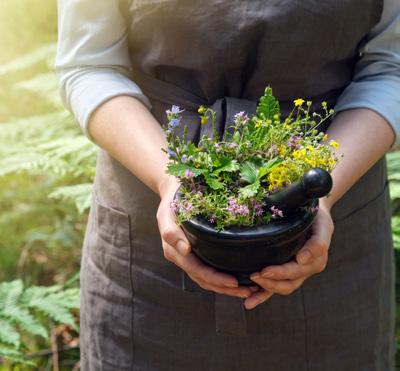

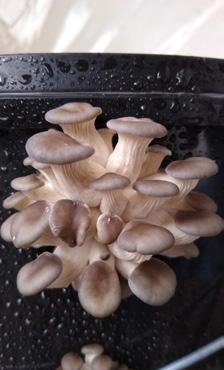










7 CONTENTS IN THIS ISSUE OF GARDEN CULTURE : 9 Foreword 11 Author Spotlight 12 Marketplace 18 How I Became a Mushroom Grower 20 Creating a Balanced and Resilient Food System 28 Eco-Optimism: Mushroom Monday 30 The Coles Notes on Herbal Tisanes 34 Mushroom Cultivation and the Problem With Pests 38 Gardening for Life - A Natural Alternative ‘Medicine’ for Health 42 Watering as an IPM Tool 44 Growing Ginger and Turmeric in Autopots 46 Unlock Peak Plant Performance with Lactic Acid Bacteria 48 Building and Pimping Out a Greenhouse 52 Triacontanol - Nature’s Gift to Growers? 56 Addressing the Unicorn in the Room - Hypochlorous Acid 60 A Fungal Revolution 69 All Things Fungi Festival 70 “Bucket Tek” – An Easy Way to Grow Oyster Mushrooms at Home 78 Notes from a Dirty Old Gardener - Garden Apathy 80 If at First You Don’t Succeed…Trich,Trich Again?! 82 We Like Trich: Remediating a Reputation 91 Local Growers 96 5 Cool Ways Mushrooms Help Boost Human Health 91 LOCAL GROWERS 82 12 MARKETpLACE 20 THE COLES NOTES ON HERBAL TISANES 70 TRICHODERMA: REMEDIATING A REPUTATION 30 CREATING A BALANCED AND RESILIENT FOOD SYSTEM “BUCKET TEK” AN EASY WAY TO GROW OYSTER MUSHROOMS AT HOME
T5 LED Lighting Fixtures


Available in 4 Sizes:
2ft (2 tube) 2ft (4 Tube) 4ft (4 Tube) 4ft (8 Tube)


Energy e cient LED lighting for propagation, supplementary and aquarium applications
Low heat output
50’000 hours lifespan
Colour Temperature: 6500K
Ideal for seedlings, vegetating plants & supplementary blue lighting
Low running costs, up to 50% more e cient than T5 fluorescent tubes
Superior light quality for enhanced plant growth
Highly reflective aluminium reflector
2 x hanging points (horizontal or vertical)
3.1m power cable
Spare T5 LED tubes also available


Powered by

UK Hydro Store Survey Time
If you are a store owner/manager/employee in the UK, please take a moment to fill out Garden Culture Magazine’s biannual survey online. The survey closes Jul 15, 2024. The results will appear in the next edition!



gcmag.co/ 2024Survey



























www.hy-gennutrients.com SOCIAL MEDIA LOGOS P ACK SOCIAL MEDIA LOGOS P ACK TRUSTED BY SERIOUS GROWERS SINCE 1994
Alex Field
Alex Field is the newest writer to grace the pages of Garden Culture Magazine, and we are so thrilled to have him on board! Mushrooms are turning heads around the globe as we learn more about their benefits for people and the planet. If you want to learn more about them or grow your own, Alex is your guy, and we’re
excited to share his knowledge with you in this edition and beyond.
Do you have a favourite mushroom variety?
I love Oyster Mushrooms for their sheer determination and how they can help us clear up the planet. Oyster mycelium can eat oil spills, clean contaminated rivers, decompose plastic and even digest atomic waste. And then grow mushrooms from it! Although maybe I wouldn’t eat those ones…
Oyster growing kits have been deployed to disaster zones to grow from rubble, old clothes and cardboard to provide food for those in urgent need. They’re hardy, nutritious, resilient, and they taste fantastic. And you can learn to grow them in this issue!
What are some of your favourite meals to make using mushrooms?
Lion’s Mane ‘steaks’ are pretty unbeatable. They taste a bit like lobster and go great with new potatoes and greens. Shiitake mushroom stew gets me excited. And Oysters. In. Anything.
Oyster mycelium can eat oil spills, clean contaminated rivers, decompose plastic and even digest atomic waste
How would you encourage others to dabble in the world of mushroom growing?
Did I mention Oysters? They’re a great place to start as they’re easy to grow and give abundant harvests with little need for fancy kits. Be warned, though – I think of them as a ‘gateway’ mushroom, as it’s hard to stop there once you’ve caught the fungi bug. Be prepared to sacrifice your spare bedroom to your future mushroom empire!
Do you have any future travel plans or destinations on your bucket list?
I’d love to go back to India. There’s a lot in the outlook and way of life there that nourishes me – along with the challenges of being in a very different context. Cows are revered in India – and it has been suggested that a reason for this is the very special mushrooms that grow out of their dung…
If you had a superpower, what would it be?
To be fully present all the time. To love everything that I find inside myself and in the world. Also, teleportation sounds like fun. 3
Alex is the founder of Fungi Tribe. He loves empowering people to grow their own food and medicine. He has taught over 6,000 students worldwide to cultivate mushrooms at home. For more information, visit: fungitribe.com or follow Alex on Instagram at instagram.com/fungi_tribe

AUTHOR SPOTLIGHT AUTHOR SPOTLIGHT 11 Are you interested in writing for Garden Culture Magazine? We’d love to hear from you! Send us an email introducing yourself with a sample of your work editor@gardenculturemagazine.com



MEGA GROW 1000
If you want fast production, Growmax Water’s MEGA GROW 1000 will produce up to 40 L/h of pure water! This Garden Reverse Osmosis unit removes up to 95% of salts and heavy metals and up to 99% of chlorine and other chemical contaminants, such as oils, gases, benzene, detergents, etc.
Mix low-EC, chlorine-free water with your perfect nutrient solution to give your plants the best possible start. The MEGA GROW 1000 from Growmax Water comes ready for a hassle-free installation, with optional indoor and outdoor connections, tubing, and a shut-off valve.
No waiting with the MEGA GROW 1000 – up to 40 litres per hour! Learn more: GrowmaxWater.com


What if the best fertiliser for soil was a hydro
fertiliser ?
Most fertiliser options seem rather complex: two bottles for growth, two for flowering, and essential supplements. That’s why Terra Aquatica created TriPart® fertiliser: complete, easy to use, and effective. With its three parts, it meets the needs of plants at every stage of their life, whatever your playground (hydroponics, coco, or soil).
Used by top universities and research laboratories, including NASA,TriPart® remains the ultimate formula, based on over 30 years of testing. It goes beyond basic nutrients by offering a full range of chelated micro-nutrients for optimal absorption and stability.
TriPart® Micro, available in soft and hard water formulas, optimises calcium levels in the nutrient solution, avoiding the blockages and deficiencies often seen with universal fertilisers.
Available in: 0.5 L, 1 L, 5 L, 10 L, 60 L and 1000 L. Check out
DAYLIGHT 60W UVA/UVB LED bar
PAR spectrum lighting is something easily proven and quantifiable, directly affecting photosynthesis and allowing a plant to grow. Less obvious (but still of huge importance) is the impact that spectrums of light outside the PAR range have on your plants. Whilst not directly contributing to photosynthesis, they do impact plant morphology and overall genetic expression. The DAYLIGHT 60W UVA/UVB LED supplemental bars allow the grower to tweak their spectrum, encouraging the best from their plants. Whether used independently
Dirt Bag Grey Fabric Grow Bags from Highlight Horticulture
These round, non-woven fabric breathable plant pots continue the tradition of promoting healthier, airpruned, efficient root systems.
Dirt Bag Grey Fabric Grow Bags made with 100% recycled plastic are tough and eco-friendly, too. Easy to wash and reuse, they are perfect for gardeners who appreciate both quality and sustainability. Whether you’re a seasoned pro or just starting, these pots help your plants grow to their full potential, combining durability with great value.They are available in a range of sizes and designed to integrate effortlessly with popular grow systems like Mega Pots.




Available exclusively from Highlight Horticulture. Contact your local grow store today.
Unlock your plants’ lush potential with Coco•Kaya, a premium coconut substrate meticulously crafted to foster vibrant growth.This aerated medium excels at moisture retention and allows plants to thrive indoors and outdoors.
Whether you’re cultivating flavourful flowers, tasty veggies, or aromatic herbs, Coco•Kaya is the perfect choice. With a harmonious blend of cocos, peat, perlite, and fertilisers, this premium substrate enhances the gardening experience for all types of growers and promotes the well-being of plants.
Invest in the health of your plants today with Coco·Kaya by Juju Royal Julian Marley powered by Biobizz!
Visit Rastorganic.com to check out the entire line. Coco•Kaya

TerraAquatica.com for more info.
The perfect choice for pure growth and joy!

CaliTouch California’s Best Kept Secret
CaliTouch is a unique formula based on Triacontanol and cytokinin in a super-concentrated, plant-available liquid feed that you can use along with any fertilisation method.
CaliTouch triggers a hormonal response in your plant that increases chlorophyll levels, photosynthetic activity, and nutrient uptake, upregulating plants’ biological and physiological processes.
Additionally, CaliTouch triggers the release of adenosine, a fast-acting messenger that controls the transpiration and translocation of sugars and other metabolites.With a small application rate of just 2ml per 100L once a week for seven weeks, CaliTouch’s transformative results will amaze you.
Available from all good grow shops via Highlight Horticulture.

DAYLIGHT 60W Far Red LED bar
Using LED technology for growing plants has quickly become the goto option for growers wanting the best output and quality. LEDs are at the point of surpassing their traditional HID alternatives, introducing new possibilities for plant growth potential. One possibility is to fine-tune the spectrum with DAYLIGHT 60W far-red supplemental bars. These


ATA NRG Upgrade
Upgrade is a slow-release fertiliser ideal for organic growers. It is produced from natural phosphate and plant-derived ingredients and is rich in organic nitrogen to support the growing plant.
What sets Upgrade apart is its convenience. It contains beneficial bacteria of the Bacillus genus that transform the phosphates and organic ingredients into nutrients the plant can absorb easily.These nutrients are released over 75 to 100 days, providing a steady supply to the plant whenever it needs them.
ATA NRG Upgrade is the certified organic fertiliser for green growers who

CO2Gro

Home CO2 Generation Kit
Proof Is In The Pressure Home Brewed CO2
This CO2 Generation system is unlike anything on the market. It uses an acid-based reaction to generate high-purity CO2—you can see the pressure gauge on the bottle rise as the reaction progresses.
The kit includes a solenoid-controlled regulator, which allows you to dose your room exactly and is compatible with most leading CO2 controllers.
The generator is easy to fill at home with the preweighed refill packs: simply add cold water, screw the regulator on and let the reaction happen. Once the reaction has been completed, hook it up to your grow room, and your plants will feel the benefits of the enhanced CO2 levels.
For more information, go to Control-led.co.uk/co2gro-generator

Available from









How I Became A
Mushroom GROWER
How I got here...
Some of my earliest memories are of hanging out with my mum in our garden. Together, we would plant seeds and watch the baby plants poke their heads above the soil—and I knew that life was good.
Moving to a city, I forgot about the real magic that takes place when food grows from the soil. I took my veg for granted, and life was busy. Who has space for growing food in a city anyway? In my 20s, I discovered microgreens at a farmers’ market. I was impressed that the ‘superfood’ baby salad leaves had been grown hydroponically on shelving units in an indoor ‘vertical
Some of my earliest memories are of hanging out with my mum in our garden
Why Mushrooms?
Mushrooms have been around for over a billion years – long before plants and animals existed. They’re getting a lot of attention now – among foodies, health seekers and ecologists alike – and this is good news. We need their help.


BY ALEX FIELD
18
King oyster (Pleurtus eryngii ) mushrooms growing from a small plastic tub
They’re getting a lot of attention now – among foodies, health seekers and ecologists alike – and this is good news. We need their help
Now, I teach other people to grow mushrooms at home, and I’ll tell you more about how to do it in future copies of Garden Culture Magazine. First, let’s look at how mushrooms are commonly cultivated indoors.
How to Grow Mushrooms at Home
Most mushrooms can be grown relatively easily at home with little equipment. Different species have varying appetites and specific preferences, but generally, most mushrooms are cultivated using the three stages below.
Stage 1. Making Mushroom “Seeds”
Mushrooms don’t have real seeds - but grow from mycelium - so this needs to be cultivated in a highly nutritious environment to act as ‘seeds’ for planting. A common way to do this is to inject spores into sterile grain - and store them in a warm, dark place for a few weeks until the grain turns white. At this stage, spores germinate and ‘colonise’ - so that each grain becomes filled with energised mycelium.

Sterile grain, part - ‘colonised’ with mushroom mycelium

When your grain is white, you can break it up and mix it with a ‘substrate’ (mushroom ‘soil’), which differs depending on the variety of mushrooms being grown.
Then your ‘seeds’ are ready for stage 2...
Stage 2. Planting and Nurturing “Seeds” in “Soil”
When your grain is white, you can break it up and mix it with a ‘substrate’ (mushroom ‘soil’), which differs depending on the variety of mushrooms being grown. Examples of different ‘soils’ are straw, hardwood pellets (or actual logs), coconut coir, vermiculite and manure. The soil/seed mix is poured into a container like a lunchbox, tub or bag and left for a few more weeks until it has all turned into a white block.

Pouring grain spawn and substrate into a growing container
Then, you’re ready for the exciting bit...
Growing - or “Fruiting” - Mushrooms!
Now is the moment to take your container out of its ‘underground’ phase and encourage it to push out some mushrooms! At this stage, you will effectively simulate Autumn/Fall by introducing light, slightly reducing the temperature, and increasing the humidity and fresh air inside your container. You can use ambient daylight (or LEDs), ‘waft’ fresh air into your containers, and humidify with a water mister.
Now, all that’s left is to harvest, preserve and enjoy. You can put your container back into fruiting conditions as they often produce multiple flushes of mushrooms.
Stay tuned for more specific guides from Alex in future issues of Garden Culture Magazine. You can download your free Healing Mushrooms Grow Guide from Alex’s website and check out his latest growing course at fungitribe.com Follow on Instagram: @fungi_tribe 3
19
19 GROWING MUSHROOMS
Agroecology promises climate change-resilient food systems that support consumers, growers, and the land on which the food is grown. It’s a tall order, but some farms prove it’s possible.

Creating a Balanced and Resilient Food System
Without farmers to grow food, we won’t eat.

BY JENNIFER COLE 20
Without farmers to grow food, we won’t eat. So, we must pay attention when world leaders start discussing the connections between farmers and how food is grown and distributed.
In the fall of 2023, worldwide leaders met in Dubai, United Arab Emirates, for COP28. They discussed creating more sustainable and resilient food systems to combat climate change. It’s a hot topic, especially considering that total food production (farming, processing and transportation) ac counts for 26% of global greenhouse gas emissions (GHG) [1] . Building resilient food systems to keep people fed is nec essary, with a global population projected to hit 9.7 billion by 2050 [2]
Drought, excessive rain, heat, and temperature extremes related to climate change have caused massive crop failures. Since 2022, over 36 million people in East Africa have been or are impacted by drought [3] . Smallholder farmers and their families are facing hunger as their ability to grow food or generate the income necessary to grow dwindles. Crop loss leads to less food and unemployment. The world’s agrifood systems employed over one billion people in 2019, and half of the world’s population lives in households linked to agrifood systems [4]

There’s a lot at stake. Many believe the answer is agroecology. Advocates say agroecological food systems elevate food security, repair broken supply chains, promote soil health and biodiversity, and sequester carbon while securing the rights
of small farmers, women, and seasonal workers. A United Nations International Panel on Climate Change (IPCC) report says that agroecological farming could cut carbon and greenhouse emissions by 2.8 - 4.1 GtCO2e per year [5] . The UN’s Food and Agricultural Organisation (FAO) echoes this by saying that agroecological food systems are better positioned to avoid market and supply chain disruptions caused by climate and societal shocks, such as pandemics [6]
2121
FOOD SYSTEMS FARM AS FACTORY Food retailers Community Community FARM AS ECOSYSTEM • Jobs • Food • Land protection • Income for workers and businesses • Labour • Income • Supporting services • Public plant & livestock breeding • Seeds saved year to year • Livestock bred on farm • Inputs produces on farm • Soil fertility preserved by cycling nutrients • Varieties chosen to to succeed in the local climate • Soil degradation • Runoff of chemical inputs
waste products
Air pollution • Job loss from mechanisation • Low wages and exploitative labour practices • Inhumane conditions • Disconnect between farm and community COSTS INPUTS Feed companies Processers Chemical companies Equipment manufacturers Seed companies $ $ $ $ $ $ $ $ $ FOOD PRODUCT Industrial Food System Agroecological Food System
and
•


By incorporating pollen-based banker plant systems, growers enhance the effectiveness of natural pest management strategies and protect crops in a more sustainable and eco-friendly way
Natural Growing
Other growing methods, like regenerative agriculture, have a set list of rules for growing food. On the other hand, agroecology is not easily defined by one strict set of practices.
Karla Cox of Plot Twist Farms in Penticton, British Columbia, practices agroecology on her farm and compares it to a programme running in the background [7]. The overall growing concept has the space to support practices such as permaculture, regenerative growing, and biodynamic farming.
For Cox, agroecology is simply about working with nature and gently allowing what she grows to adapt to the surrounding conditions. Systems that mimic nature are traditionally considered more adaptable to changing conditions and can provide farmers more stability during climate disasters, such as excessive rain or drought. Just as nature is diverse, so is what Cox plants.
In 2023, the scientific journal Environment Management published the paper Agroecology Can Promote Climate Change Adaptation Outcomes Without Compromising Yield In Smallholder Systems. Researchers analysed 77 cases of agroecological treatments compared to conventional practices. Crop yields using agroecological methods, including organic nutrient sources and diversifying systems with legumes, showed higher yields in 63% of cases [8]
A Growing Movement
But agroecology is more than just a practical growing guide. Canada’s National Farmers Union (NFU) advocates for agricultural policies that ensure dignity and income security for farm families [9]. NFU’s former youth vice-president, Ayla Fenton, writes on the NFU’s website that agroecology is more than what it seems. It is also a political and social system, a way of life, a form of resistance against corporate control of the food system and the only means of achieving food sovereignty. Jessie McInnis of Spring Tide Farms in Nova Scotia is a national youth representative for the NFU and an agroecological farmer [10]
“Agroecology is more of a way of life than a set of farming practices,” she confirms. “It involves just as much off-farm political work as on-farm ecological practices.”
To understand agroecology better, she suggests taking a look at its history. The term was first coined in 1928 by American agronomist Basil Bensin [11]. Ecology studies the interrelationship of organisms and their environments, and agroecology was initially designed to examine those interactions as it applies to agriculture. In 1993, as a way to counter the industrialisation of food systems in Latin America and how they were disrupting the

ecological relationships and traditional balances between people, land, and food, agricultural workers formed the grassroots movement La Via Campensia, the grandfather of modern-day Agroecology [12]
Balanced Ecosystems
La Via Campensia’s Declaration of the International Forum of Agroecology lays out the basic tenets of 21st-century agroecology [13]
Along with the NFU, they imagine a food system that protects access to land, water, knowledge, farmers and food culture. For example, using ecological growing practices that naturally nurture the soil, inputs such as fertiliser and pesticides are unnecessary. This eliminates the corporate supplier that profits off the small farmer’s needs and reduces GHG emissions. In 2023, synthetic nitrogen fertilisers for growing contributed to 5% of global GHG emissions [14]. The rights of small farmers and agricultural workers and their ability to care for the land, health, and access to a fair living wage are prioritised. This links back to the consumers because if farmers can’t work, we don’t eat.
“When you start a farm or garden, you create a community, below and above the soil,” Cox explains.
The microbes in the soil bring nutrients to the plants, which grow and provide nectar for the bees and insects that pollinate the crops. It’s a diverse ecosystem in which everything plays an equally essential and balanced part, supporting all its components. This is what agroecology hopes to achieve for the environment, the people who grow food, and those who eat it. 3
2323
FOOD SYSTEMS
FOR EXCELLENCE MADE BY
ESSENTIALS
Plot Twist Farms
Location: Penticton, British Columbia
Instagram: @plottwistfarmsbc
Farm philosophy: To empower, transform and grow as a community holistically and naturally.
What we grow: Beans, beets, broccoli, broccolini, green cabbage, carrots, cauliflower, turnip, salad greens, radicchio, leeks, onions, peas, peppers, jalapeños, potatoes, squash, and 14 varieties of heirloom tomatoes, flowers and herbs.
Growing method: Biodynamics
How we use agroecology on the farm: “I aim to create a balance with nature to allow the ecosystem to thrive by making small adjustments and encouraging a multitude of species to coexist, recognising that biodiversity creates resilience.”
– Karla Cox: Plot Twist Farms.



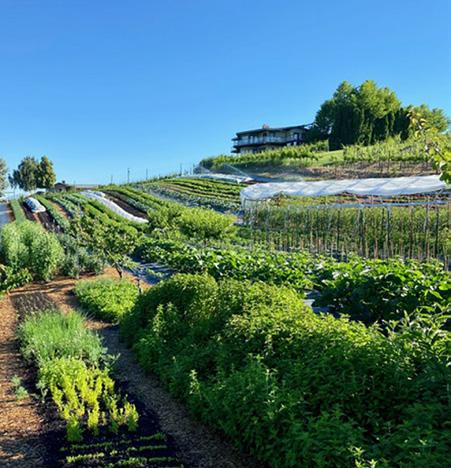
2525
FOOD SYSTEMS


Spring Tide Farms
Location: Lunenburg County, Nova Scotia
Instagram: @springtide.farm
Farm philosophy: Sustainability. Organic. Local.
What we grow: Cabbage, radishes, turnips, carrots, beans, cucumber, peppers, leeks, tomatoes, celery, assorted herbs, fennel, eggplant, potatoes, and 60 varieties of cut flowers.
Growing method: Regenerative, no-till agriculture.
How we use agroecology on the farm: “It’s a holistic approach to food production that uses and creates social, cultural, economic and environmental knowledge to promote food sovereignty, social justice, economic sustainability, and healthy agricultural ecosystems.”
– Spring Tide Farms.

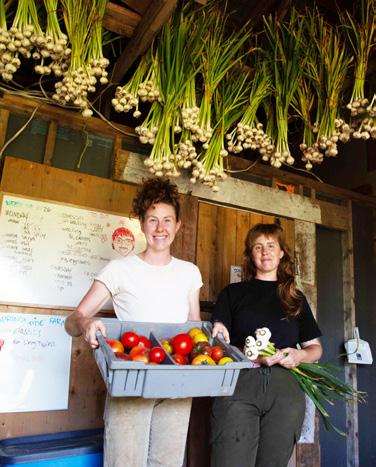

Footnotes:
1. Environmental Impacts of Food Production - Our World in Data (ourworldindata.org)
2. Population | United Nations (un.org)
3. The world cannot afford to ignore drought in the Horn of Africa (unicef.org)
4. Almost half the world’s population lives in households linked to agrifood systems (fao.org)
5. Food-system-transformation-at-COP28.pdf (pan-uk.org)
6. Overview | Agroecology Knowledge Hub | Food and Agriculture Organization of the United Nations (fao.org)
7. PLOT TWIST FARMS BC (plottwistfarms.com)
8. Agroecology Can Promote Climate Change Adaptation Outcomes Without Compromising Yield In Smallholder Systems - PMC (nih.gov)
9. National Farmers Union | Strong Communities. Sound Policies. Sustainable Farms. (nfu.ca)
10. HOME | Spring Tide Farm (springtidefarm.ca)
11. What is agroecology, and how can it provide solutions to crises that plague our food systems and create food democracies? | IATP (iatp.org)
12. Via Campesina: Globalize the Struggle, Globalize Hope! (viacampesina. org)
13. The Declaration of the International Forum for Agroecology (foei.org)
14. Fertiliser emissions could be cut to ‘one-fifth’ by 2050 | World Economic Forum (weforum.org)
27
FOOD SYSTEMS
ECO-OPTIMISM
Mushroom Monday Enters the Weekly Meal Rotation

Mushrooms are healthy, delicious, and dang good for the environment. Need we say more? This edition’s eco-optimism feature encourages you to incorporate these gems into your meals. Bon appetit!
We’re already addicted to Taco Tuesday; now it’s time to jump on the Mushroom Monday bandwagon! Mushroom Monday is celebrated at restaurants and homes worldwide as people look to eat more healthy, earth-friendly foods. Mushroom cultivation is sustainable and can boost food security because it happens 24/7 and 365 days a year. Unlike greens, mushrooms don’t need light to grow and don’t require much water, either. According to The Mushroom Council , growing one pound of ‘shrooms only takes about 1.8 gallons of water. The growing cycle is quick; mushrooms double in size daily! Nutritious, delicious, and sustainable? We’re putting Mushroom Mondays into our weekly meal rotations. How about you?
Nutritious, delicious,
and
sustainable? We’re putting Mushroom Mondays into our weekly meal rotations. How about you?
The Mushroom Council (@mushroomcouncil ) offers plenty of tasty recipes for easy weeknight meals, including pasta with creamy mushroom sauce, beef & broccoli with mushrooms, and three mushroom and garlic grilled pizza. For mushroom enthusiasts serious about their culinary adventures, Krista Towns is releasing a beautiful cookbook called Mushroom Gastronomy: The Art of Cooking with Mushrooms . A member of the North American Mycological Association, Towns knows mushrooms. She’s the editor of FUNGI magazine and the culinary advisor and recipe developer for Circular Farm in Jackson, South Carolina. Her book is perfect for those curious about new mushroom varieties and their health ben -
efits, and those concerned about the environment and wanting to eat less meat. It features gorgeous photographs and information about 25 of the most popular edible mushrooms and their unique nutritional values, ideal cooking methods, and flavour pairings. Learn how to make mouth-watering meals like Black Trumpet Mushroom and White Bean Bisque, Morel Mini Quiche, Chicken of the Woods Saltimbocca, Matsutake Tempura, and more. We’ll get you started with one of the book’s recipes, Lion’s Mane Bolognese.

28

Serves 3 to 4 I Vegetarian
A flavour-rich bolognese is usually well worth the time it takes to prepare. Luckily, this mushroom bolognese takes less time than the traditional meat version, but still, it’s absolutely necessary to patiently allow the layers of flavour to develop slowly by caramelising the vegetables at each step. And don’t forget the Parmesan rind!
• 2 tablespoons olive oil, divided
• 1 tablespoon butter
• 1⁄2 onion, finely chopped
• 1⁄2 teaspoon kosher salt, plus more as needed
• 1⁄2 fennel bulb, finely chopped
• 1 small carrot, finely chopped
• 3 garlic cloves, minced
• Pinch of red pepper flakes
• 8 ounces lion’s mane mushrooms, finely chopped (about 3 1⁄2 cups)
• 2 tablespoons double-concentrated tomato paste
• 1⁄2 cup dry white wine
• 14 ounces (about 2 cups) passata or San Marzano tomato sauce
• 1 cup roasted vegetable stock or chicken stock, divided
• 1 cup whole milk or cream, divided
• 1 Parmesan rind
• Freshly ground black pepper
• 12 ounces dried spaghetti or another long pasta
• 1⁄4 cup grated Parmesan cheese, plus more for serving
Heat 1 tablespoon of the olive oil and the butter in a large saucepan over medium heat. Add the onion, a pinch of salt, and cook for 2 to 3 minutes, or until translucent. Add the fennel, carrot, and a pinch of salt and sauté for 10 to 12 minutes, or until the vegetables are softened and caramelised. Stir in the garlic and pepper flakes and cook for an additional minute.
Add the remaining 1 tablespoon of olive oil to the pan, stir in the mushrooms, 1⁄2 teaspoon of salt, and cook, until the mushrooms turn golden brown, 5 to 6 minutes. Add the tomato paste and cook, stirring often, for 3 to 4 minutes, or until the mixture is thickened and the paste has lost its bright colour. Stir in the wine and cook until it reduces by half. Add the passata, 1⁄2 cup of stock, and 1⁄2 cup of the milk and stir until combined. Add the Parmesan rind and cook at a low simmer, for 45 to 60 minutes, adding a little more stock and milk as the mixture cooks down, until the flavours have developed and the sauce has thickened. Remove the Parmesan rind, and then taste and adjust the seasoning with salt and pepper.


Bring a large pot of salted water to a boil over high heat. Add the pasta and cook for 7 to 10 minutes, or until al dente. Drain the pasta, reserving 1⁄2 cup of the pasta water. Add the pasta to the pan with the sauce and toss to combine. Add a little of the pasta water and continue to toss and cook—the pasta sauce should cling nicely to the pasta. Add the grated Parmesan cheese and toss thoroughly. Serve with additional Parmesan cheese.
Mushroom Gastronomy: The Art of Cooking with Mushrooms, written by Krista Towns, is published by Gibbs Smith and available online and in bookstores everywhere. 3


29
29 MUSHROOM MONDAYS
Krista Towns

Herbal tisanes tisanes


The process of planting, growing and distilling the flavours of herbs into a healthy tea isn’t just good for individual well-being; the connections between people and the garden during the process are equally important for good health.
BY JENNIFER COLE
30
Katie McGillivray is a horticultural therapist who promotes health, healing and well-being through plant and garden activities.
“Whether I have access to a sprawling garden or a few pots of herbs on a balcony, herbal brews are one of my favourite therapeutic horticulture activities,” she says.
Many of McGillivray’s clients are elderly and experience the joys of fresh air and working in a garden setting. Their physical health is improved by brewing herbs like chamomile into a tea. Harvard Health says this popular garden brew made from the flowers of the chamomile plant contains a myriad of antioxidants and minerals that can lower the risk of heart disease and slow bone density loss [1]. But don’t make the mistake of calling it tea!
Tisanes Vs. Tea
Heather A. Webb is a trained tea sommelier, avid gardener, and author of the Tea in the Garden book series, which includes herbs, teas, and tisanes [2]
“For the brew to be a true tea, it has to contain the leaves of the Camellia sinensis plant,” she explains. “If you are making tea from herbs, it is called a tisane, not tea.”
Originally a French word, tisane is the crushing, cutting, and tearing of various dried flowers, fruits, or herbs steeped in boiling water. Originating from the Greek “ptisane,” meaning crushed barley, the term refers to the barley infusions plus other herbal concoctions the ancient Greeks used to treat and maintain good health [3]. In the 1st century, Greek physician Dioscorides listed almost 600 medicinal plants that could be steeped in water to create healing infusions [4]
Throughout history, tisanes have continued to be associated with healing and well-being. In Europe during the Middle Ages, monasteries grew and dispensed herbs with specific instructions on making them into tisanes to treat everything from colds to stomach aches [5]. The sun-loving hyssop, with its tall purple spikes attractive to bees and hummingbirds, was once used to treat respiratory disorders. Even today, research published in the Journal of Food Science promotes hyssop to help maintain a healthy digestive system [6] .
Growing a Tisane Garden
If you grow herbs for savoury dishes, you can grow them for tisanes. Some herbs, such as peppermint and basil, can be grown indoors during the winter, so you will always have that much-needed soothing cuppa on those cold, dark winter days.

Harvard Health says this popular garden brew made from the flowers of the chamomile plant contains a myriad of antioxidants and minerals that can lower the risk of heart disease and slow bone density loss

The popular variety of basil known as holy basil or tulsi is the only variety suitable for tisanes. It flourishes outside in climates where the year-round temperature stays moderate, between 70 and 85°F (20-32°C) [7]. During winter in cold climates, keep the plant on a bright, warm windowsill and use it to relieve the symptoms of colds and flu.
Although most herbs can tolerate some shade, a spot inside or out that gets four hours of sunlight daily is ideal. Of course, soil matters. A loamy, well-draining garden soil is perfect for growing herbs. Most will thrive in an open garden bed with perennials or a dedicated herb garden. Some, however, such as lemon verbena or mint, will want to spread their wings and can become unruly in the orderly garden bed. Containers one to three times the diameter of the height of the plant’s foliage at maturity are great options for these herbs. Especially since keeping them is well worth the effort. The Journal of the International Society of Sports and Nutrition indicates that lemon verbena’s crisp, refreshing flavour may help prevent and heal muscle injuries [8]. Research is limited, but peppermint oil in peppermint tea may improve memory [9][10] .
The best time of day to harvest herbs for tisanes is in the morning. The plants have been fed by overnight dew and are at their peak of flavour. Pick the leaves or flowers of the herb and either brew it right away or hang it to dry. The quickest way is to tie the stems up in little bundles—no more than an inch thick– and then hang them upside down in a dry place with good ventilation. After drying, store the herbs in an air-tight container and label with the herb’s name and the date harvested. Dried herbs typically last up to three years [11]
31
Credit:
Katie McGillivray
31 HERBAL TISANES


McGillivray says therapeutic horticulture is about the process rather than the result. The experience of growing, harvesting, and blending herbs is as essential for overall well-being as the tisane itself.
32
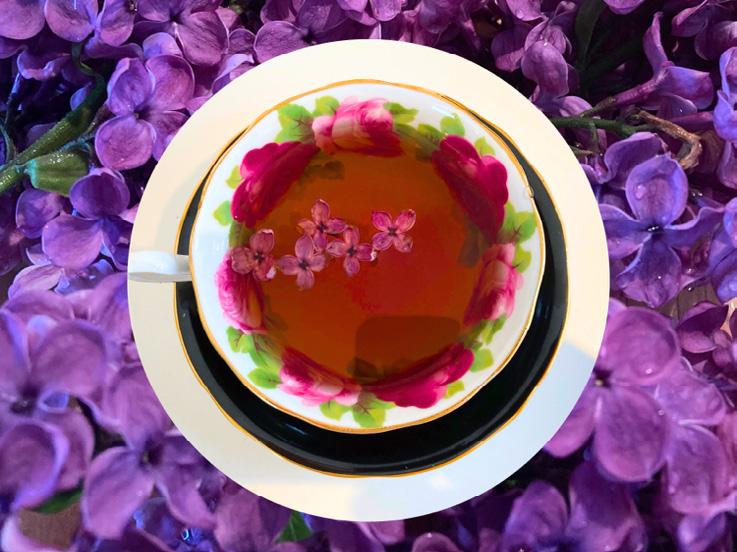
Making a cup is a form of self-care, getting you into a me-time mindset.
Due Diligence
There is no end to the herbs, fruits and other plants that can become a tisane.
“I love watching my clients taste a new flavour for the first time, such as lavender or other concoctions we dream up together,” McGillivray says.
Integrative medicine specialist Yufang Lin, MD of the Cleveland Clinic, writes that lavender tea has the biggest bang for your buck [12]. Making a cup is a form of self-care, getting you into a me-time mindset. A lavender tisane is excellent for sleep and de-stressing.
But, before brewing your garden-grown herbal tisane, research or consult a herbalist so you don’t get sick. The compounds in plants are potent and, if brewed improperly, will cause poisoning. Some herbs are a contraindication for specific medical conditions or don’t interact well with medications. Online courses on herbs are offered through community colleges or Naturopathic schools. Once you have researched, growing a garden full of herbs and turning them into refreshing tisanes will be even more enjoyable.

McGillivray says therapeutic horticulture is about the process rather than the result. The experience of growing, harvesting, and blending herbs is as essential for overall well-being as the tisane itself.
“There are few things more magical in the garden than harvesting a bouquet of aromatic herbs and transforming them into an infusion of flavours and experiences that you can taste and share,” she says. 3
Footnotes:
1. The health benefits of 3 herbal teas - Harvard Health (health.harvard.edu)
2. Heather A. Webb (heatherawebb.com)
3. tisane | Etymology of tisane by etymonline (etymonline.com)
4. Pedanius Dioscorides | Royal College of Physicians of Edinburgh (rcpe.ac.uk)
5. Medieval History – Herbal Medicine in the Middle Ages (historymedieval.com)
6. Evaluation of the Antioxidant Potential of Hyssop (Hyssopus officinalis L.) and Rosemary (Rosmarinus officinalis L.) Extracts in Cooked Pork Meat - Fernández- López - 2003 - Journal of Food Science - Wiley Online Library
7. 5 Health Benefits of Holy Basil (clevelandclinic.org)
8. Effects of lemon verbena extract (Recoverben®) supplementation on muscle strength and recovery after exhaustive exercise: a randomized, placebo-controlled trialPubMed (nih.gov)
9. 12 Science-Backed Benefits of Peppermint Tea and Extracts (healthline.com)
10. Modulation of cognitive performance and mood by aromas of peppermint and ylangylang - PubMed (nih.gov)
11. Do Spices Expire? Shelf Life and When to Toss Them (healthline.com)
12. Lavender: Health Benefits and How To Use It (clevelandclinic.org)
BIO Jennifer Cole is a writer and garden enthusiast with a bachelor’s degree focused on history from Simon Fraser University, and a freelance writing career spanning two and half decades. Jennifer lives in Vancouver British Columbia. Her by-lines have regularly appeared in the opinion section of the Toronto Star and her portfolio includes articles in various newspapers, magazines, and websites across Canada. When not writing her own blog or visiting local garden centres, you can find her puttering, planting, and nourishing her own urban garden oasis.
3333
HERBAL TISANES
Credit: Katie McGillivray
Mushroom Cult
The use of mushrooms as medicine dates back thousands of years and is increasing in demand as we once again begin to understand the vast benefits for our health. Cultivating mushrooms is a growing industry, but it can be challenging. Depending on the species and the overall set-up for cultivation, you may encounter some pests that are also interested in the benefits of mushrooms with little regard for your yields.
Cultivating mushrooms is a growing industry, but it can be challenging


Without proper sanitation, you risk bringing bugs into your cultivation room, a perfect environment for them to feast and reproduce
ANDREA KEDDY 34
BY
Purple Springtails Collembola on the fruiting body of the mushroom.
ivation
and the Problem with Pests
Decomposers
Many mushroom pests fall into the category of decomposers. Flies in the sciarid, phorid and cecid families are known decomposers found throughout the world. Springtails, mites and nematodes are often present in the growing media needed for certain varieties of mushrooms. While the role of decomposers is critical in the environment, they can make mushroom cultivation near impossible when sanitation precautions are lacking. These annoying pests are drawn to the smell of composts and mushrooms, have a fast reproduction rate, and can infest all stages of mushroom cultivation. If present at the spawning stage, they might make it challenging to get a crop to harvest.

Keep it Clean
Sanitation is critical to healthy mushroom cultivation. Your set-up must include exclusion methods like screening on all vents, light traps for flying adults, and pasteurisation of growing media. These pests’ larval stages cause the most damage, with eggs likely found in the growing media. Without proper sanitation, you risk bringing bugs into your cultivation room, a perfect environment for them to feast and reproduce.
Pest Problems
The sciarid and phorid flies will feed on the compost media, the mycelium and mushrooms, while the cecid flies will focus on the mycelium and stipe. When there is an attack at the pin head stage, development often stops, and the pin heads eventually die. Flies in the sciarid family are also known to spread spores of fungi such as Trichoderma that may be pathogenic to cultivation. Mites may be introduced on poor quality compost or be spread by the phorid flies. That’s right; mites will attach themselves to the phorid flies and travel around using the flies as a private plane. Springtails are connoisseurs of mycelium and can cause the mycelium to disappear completely. They also feed directly on the gills of oyster and shiitake species.
The Solutions
If you face unwanted visitors, some biological-based solutions can be applied to mitigate the infestation while the crop grows. Beneficial nematodes such as Steinernema feltiae are well-known to control flies in the sciarids family. This beneficial nematode can be applied directly to the growing media and will infect the larval stage of the sciarids, liquefying their innards. Soil-dwelling predatory mites such as Stratiolaelaps scimitus spend their days hunting out the larval of sciarids, springtails, mites and other insects in the media. They can survive without a food source for seven to eight weeks. Because they can go without food for so long, this predatory mite can be applied preventatively to new growing media after pasteurisation. This is the preferred biological control as it targets a wider variety of potential pests that may be present in the cultivation area.
After Harvest
Once the harvest is complete, clean the growing area thoroughly. Heat treatments in the empty growing area can kill pathogenic fungi spores and insects hiding in small cracks and crevices uneasy to reach with disinfectants. Spent compost should be disposed of far away from the cultivation area to avoid pests from returning. Trapping methods for flying insects should be included in your preventative measures. For every adult female caught in a trap, you’ve removed dozens, if not hundreds, of her offspring from breeding in your crop. While sanitation is the most critical aspect of avoiding these pests, there is some comfort in knowing that not all is lost should they appear. 3

3535 35
MUSHROOM PESTS
Stay
up-to-date
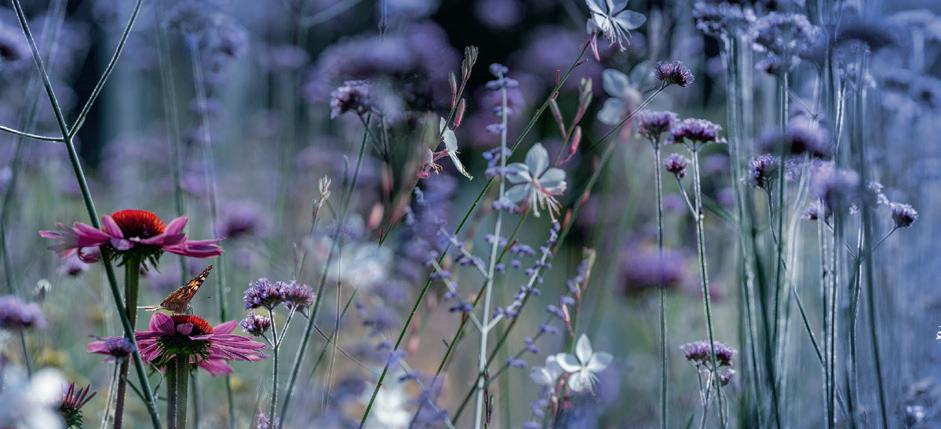
with
Culture Blog
Garden Culture Blog
Our blog is where we bring you more than we can cover in our print issues; timely news, growing tips, and great ideas. Hundreds of growing articles are waiting for you.




our
@gardenculturemagazine
GCMAG.co
Stay up-to-date with our Garden

Gardening for Life
A Natural Alternative ‘Medicine’ for Health
Gardening offers many options for an enjoyable form of alternative medicine


BY ANNE GIBSON
38
Mental and physical illness and health care costs are rising globally. Optimum health isn’t just physical wellness without the symptoms of chronic illness. Wellness also encompasses a positive mindset and the ability to fully function daily; this includes social and emotional health, personal enrichment, improved diet and nutrition. Significant and compelling evidence shows that gardening improves health and wellbeing.

Gardening offers many options for an enjoyable form of alternative medicine. Global studies show gardening improves our health and wellbeing at all ages, particularly in ageing adults. An extensive and growing body of research verifies that interactions with nature in the garden can prevent and reduce the impacts of many diseases. With populations getting older, escalating mental illness, and urbanisation contributing to many health problems, gardening is recommended to governments as a practical way to reduce the impact and cost of health care.
We garden for various reasons—to beautify our properties, grow food, for leisure, to eat healthier and save money, to connect with the community and wildlife, and more. However, we may not realise how beneficial half an hour of moderate exercise in the garden is to our health or that spending time outside with nature can boost our quality of life.
Garden Therapy and Grief
I know from personal experience how powerful a role the garden plays in lifting the spirits and combating depression, anxiety and grief. I provided palliative care for my mum for the last six months of her life during stage 4 cancer. It was an incredibly stressful time. Terminal illness takes a massive toll on the patient and the carers, especially the family. It was physically and emotionally confronting and demanding with 24/7 care. Trying to stay positive and happy when the days of someone you love

are limited is challenging. It’s like looking into a dark tunnel with no light at the end.
One of the ways we coped was garden therapy. Mum was in pain and unable to walk long distances. She needed a wheelchair or walking aids, so she couldn’t enjoy my large garden’s beauty. We discussed her favourite plants, colours and flowers. I established a mini garden so she could access it easily. I set up containers with fragrant, beautiful and colourful blooms on my patio under the shade of a lovely tree. We spent time outdoors looking at the view and smelling the flowers daily. It was incredibly healing to the mind, body and soul. Listening to the birds and insects, the visual stimulation and enjoying a cup of tea in the garden together helped us both. I could pot up or water a few plants close to the house, giving me a sense of purpose and staying connected to my garden in a small way. I sowed seeds, and we watched them grow together, a daily reminder there’s hope for the future and joy each day.
After she passed, I could finally venture out to my large kitchen garden, which had been neglected for six months. I cried and grieved. I expected it to be a wild mess with dead plants. However, the incredible gift was seeing that those dead plants had self-sown and hundreds of new seedlings were growing in their place. They filled the gap, and seeing new life gave me hope for healing and helped me through my grief.
Beyond this experience, there are impressive research findings that help our health in many other ways.

Having a common interest in gardening promotes meaningful social connections and health outcomes
NATURAL MEDICINE 39
connections and improved mental health are benefits of participating in community gardens and nature therapy

What do studies reveal?
These are just a few of the key outcomes:
• Faster healing and fewer pain medications (1,3)
• Reduced stress, depression, fatigue, anger and anxiety symptoms (1, 2)
• Preventative medicine (3)
• Better sleep and improved diet (3)
• Reduction in sickness, mental health conditions and death (3)
• Reduced dementia risk (5, 6)
How Gardening Benefits Health
Planning and designing a garden imparts a sense of purpose, which is vital for mental health. Nurturing and raising plants provide the opportunity for creativity, problem-solving, learning, mental stimulation, enhanced self-esteem, self-reliance, and self-sufficiency. These opportunities are even more critical for older adults as they retire or have less contact with their families and work colleagues. Gardens provide an outlet for a wide variety of skills, personal expression and values, a sense of identity, the ability to contribute to improving the environment and a practical way to continue leading a productive life.
Instant and Ongoing Benefits
Multiple studies have found exciting health benefits of gardening for any time. Three studies revealed that only several hours of exercise in the garden can immediately benefit health, such as reducing depression and anxiety symptoms (Hayashi et al., 2008; Rodiek, 2002; van den Berg and Custers, 2011) (2)
An extensive list of other studies (2) has confirmed that horticultural therapy with patients suffering severe depression and impaired cognitive function found there were health benefits from gardening activities three months after therapy. Seven studies (2) on daily gardening outcomes found participants had reduced stress and BMI (body mass index) and increased general health and life satisfaction. Repeated short-term exercise from daily gardening activities resulted in a “cumulative effect on health.”
Some of the responsible factors identified for these positive outcomes include:
• Direct contact with nature.
• Physical exercise.
• Healthier diet with more fruits and vegetables.
• Interactions with other gardeners in a social context (allotment and community gardens).
Community Gardening Health Benefits
Gardening in a social context provides an opportunity for enhanced enjoyment and friendships, supporting mental health outcomes. Community gardens, garden groups and clubs, and communal gardens in aged care facilities allow older adults to engage in gardening activities in various physical capacities despite limitations. For example, even if a gardener can’t physically manage the heavy lifting of pots or soil, others are willing to help. Instead, there are light exercise activities like sowing seeds that don’t require physical strength. The ability to adapt to these social garden environments is vital to maintaining mental health and avoiding depression and lack of self-esteem due to a loss of capacity.
Community gardening involves collective effort. Studies show direct contact with nature in a garden setting has positive effects on mental health due to “its tranquil, restorative, and social nature.” (4)
40
Social
Age or physically challenged adults can find creative ways to connect with a garden for health benefits


We spent time outdoors looking at the view and smelling the flowers daily. It was incredibly healing to the mind, body and soul
An interesting 2020 urban-based Singapore study (4) finds community gardens have a more positive impact on mental health than home gardens. This is likely due to the combined effects of physical activity, connection to nature, gardening experiences, shared sense of achievement and social exchange integrated into community gardening activities.
My dad is still gardening at 95 years of age in his retirement village. He weeds, prunes and plants several days a week. He enjoys creating a beautiful environment for other residents to enjoy. I’ve seen firsthand the joy, personal satisfaction and sense of wellbeing this contribution has for him and others. Despite a mild heart condition, he paces his activities to his physical capacity. Regular physical exercise builds his strength and maintains his health. Many of the elderly residents are unable to take part but enjoy the views from their balconies. The attractive ornamental and edible gardens are part of their everyday conversations. This common interest also builds community and a sense of belonging to something bigger, giving residents a reason to get outside and be more active so they can walk around the gardens.
BIO

Gardening is undoubtedly medicine for the soul and the body. Community and home gardens play an essential role in health care. Based on the evidence, gardening is cost-effective preventative medicine and an enjoyable therapeutic hobby that improves physical and psychological wellbeing. I dig that! 3
References
1. Ecotherapy – A Forgotten Ecosystem Service: A ReviewPMC (nih.gov)
2. Gardening is beneficial for health: A meta-analysis
3. Exploring the health and wellbeing benefits of gardening for older adults
4. Community Gardening: Stress, Wellbeing, and Resilience Potentials - PMC (nih.gov)
5. Lifestyle factors and risk of dementia Dubbo Study of the elderly
6. Vitamin D deficiency and leisure time activities in the elderly: are all pastimes the same?
Anne Gibson, The Micro Gardener, is an author, speaker and urban garden community educator on the Sunshine Coast, in Queensland, Australia. Anne is passionate about inspiring people to improve health and wellbeing, by growing nutrient-dense food gardens in creative containers and small spaces. Anne regularly presents workshops, speaks at sustainable living events, coaches private clients and teaches community education classes about organic gardening and ways to live sustainably. She has authored several eBooks and gardening guides. Anne shares organic gardening tips and tutorials to save time, money and energy on her popular website - TheMicroGardener.com
Maintaining a garden improves physical health and mobility
NATURAL MEDICINE 41
Watering Watering as an IPM Tool as an IPM Tool
My mentor was adamant about watering skills when I was a young apprentice grower in a commercial ornamental greenhouse. We followed the rule that you can always add more. Over-watering can cause many issues for a grower, from increasing pests and disease to upsetting the oxygen balance in the root zone. We spent hours irrigating, watering lightly according to the expected weather that day and returning to add more as needed. It was labour-intensive but saved us much time over the entire growing process. We reduced the chance of needing dry-down periods and kept pest and disease problems from taking over.
A Common Problem
As a pest management consultant, I often see water-related issues, particularly insect pests living in the root zone. Fungus gnats and shore flies can reach high numbers when the root zone is consistently moist. In low populations, these pests will likely leave your roots alone, preferring to eat organic materials, fungi, and algae. But when the environment tips in favour of the insects and is soggy for prolonged periods, we see a population explosion, and they may feast on the plant roots. The more we reduce the soil’s oxygen content by over-watering, the greater root death we see, which increases the food source (dead root tissue) for the larvae of these pests. This is especially damaging to young devel -


Fungus gnats and shore flies can reach high numbers when the root zone is consistently moist

42
BY ANDREA KEDDY
A task that appears so simple is an art form that requires practice and diligence

Over-watering can cause many issues for a grower, from increasing pests and disease to upsetting the oxygen balance in the root zone
oping plants. The attack on young root hairs reduces the uptake of water and nutrients for the plants and creates a wound for pathogens to take up residence.
Plant Pathogens
Pythium is one of many plant pathogens commonly found in greenhouses and root zones. It flourishes in wet environments. Once the hyphae develop inside the plant tissues, they release destructive enzymes that absorb nutrients. Pythium is extremely difficult to control without systemic fungicides and often causes plant death.
As these pests’ larvae develop into adults, they fly around and move from plant to plant. They carry pathogen spores on their feet and bodies, and the Pythium pathogen remains viable as it passes through the insect’s gut and spreads through excrement. If this happens, treating the insects carrying the disease and the disease itself is essential, or this vicious cycle will continue.
Valuable Lessons
I am grateful to my mentor for these lessons in proper watering techniques. A task that appears so simple is an art form that requires practice and diligence. Remember, an ounce of prevention is worth a pound of cure. 3
BIO Andrea has worked in the horticulture industry for over 20 years and specialises in using beneficial insects as the primary defense against pests. As a technical consultant with Koppert Canada, she works with growers advising on pest management strategies in crops such as greenhouse-grown vegetables and ornamentals. Andrea loves being in nature and is passionate about growing various food crops while supporting a biodiverse regenerative ecosystem.
4343 IPM WATERING
Growing Ginger and Turmeric in Autopots
Look no further if you are looking for superfoods that are easy to grow at home. I discovered ginger and turmeric are easy to grow and produce surprisingly large yields indoors in the Autopot system. If you are unfamiliar with Autopots, they are a gravity-fed bottom watering system. I mention them instead of growing conventionally because ginger and turmeric grow bigger and faster in this system. I tried regular pots and hand feeding, but it wasn’t the same. I have also tried to grow them outside, but they prefer the consistent tropical conditions of my grow room: 26°C and 50-60% RH.
Accidental Growing Ventures
Ginger was my first interest, and I grew it by accident. One day, I noticed an old piece of ginger on the counter sprouting a green shoot. I had been harvesting some plants that week and had my Autopots sitting without plants but still full of soil with a cut trunk. I nestled three pieces around the trunk and gave it some plain water.
Within about a week, I noticed the plant was growing. So, as I cleaned up the rest of the garden, I kept my ginger project going and planted two other pots. The plant grew and grew. Within two months, I had grown an impressive-looking plant. Ginger looks like tall grass when it grows, and knowing what prize could be lurking under the soil kept my interest piqued.
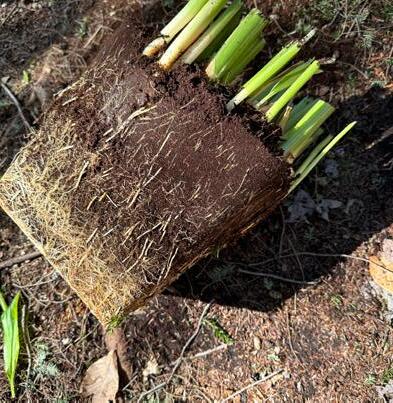
The Harvest of all Harvests
I let the plant grow for another six to eight weeks and knew it was time to harvest because all the sides of the pot were warping out under the pressure of growing roots. I had no idea what to expect with that first plant, and I was blown away! I harvested three and a half pounds of the most beautiful ginger ever. Ginger from a supermarket is brown with tough skin. But freshly harvested ginger is off-white, pale yellow, and purple when first picked. It develops the skin over a week or so when exposed to the elements.
Have you met Turmeric?
About two months into the project, I realised I needed to start more roots. I went to my local health food store because I assumed organic ginger would root better than the regular supermarket variety. I have since discovered that it all grows well, and finding ginger with little sprouts is best. Searching for the perfect ginger is how I ended up growing turmeric. It was just sitting beside the ginger, and I thought, what the hell? Turmeric grows differently

BY ERIC COULOMBE
44

than ginger; unlike the thin grass-like structure, turmeric has broad leaves similar to a palm. It takes up more room than ginger, so consider the size when planting. It takes about four to five months from root to harvest, like ginger.
Medicinal Staples
It has been seven years since my first batch of these medicinal crops. Ginger and turmeric are staples in our house and we consume them regularly. Turmeric boasts many health benefits. Curcumin, its active compound, possesses potent anti-inflammatory and antioxidant properties. These attributes make turmeric a powerful natural remedy for alleviating joint pain, reducing inflammation, and combating oxidative stress. Studies suggest it helps in managing conditions like arthritis, heart disease, and even certain cancers. Additionally, turmeric is linked to improved cognitive function and mood regulation.
Ginger, revered for centuries in traditional medicine, also offers various health benefits. Its bioactive compound, gingerol, provides the same benefits as curcumin. This root also alleviates nausea, eases digestive discomfort, and relieves muscle pain. Ginger may help lower blood sugar and cholesterol levels, contributing to heart health. Research suggests it possesses antimicrobial properties, potentially bolstering the immune system.

I discovered that ginger and turmeric are easy to grow and produce surprisingly large yields indoors in the Autopot system
Whether consumed fresh, dried or as a tea, both roots can provide a flavorful and natural boost to overall health and well-being. Plus, they are easy and fun to grow! 3
BIO Eric describes himself as a pretty happy person, and how could he not be? He’s a husband, a father, a soccer coach, and he’s also a proud Canadian. Not to mention, he’s been working in the incredibly exciting and dynamic indoor growing industry since 2002. He saw the enormous potential for expansion long ago and decided he wanted to watch the market evolve while also being apart of it. He joined Garden Culture Magazine in 2012 and in 2014, he became the owner. He has been sharing his love and passion for growing ever since.
45
45 GROWING SUPERFOODS
Unlock Peak Plant Performance With Lactic Acid Bacteria

Even if you’ve never heard of lactic acid bacteria, known more simply as LAB, these friendly microbes play an essential part in your daily life. They live in the human digestive system and help extract nutrients from food. They also work hard in the garden, cycling soil nutrients and fueling growth. Just as people take probiotics to populate their bodies with beneficial bacteria, gardeners can positively influence the microbiome of their plants to improve vigour and productivity by applying homemade LAB. Using them as a foliar spray or root drench can help to protect plants from disease, give them better access to nutrients, and facilitate superior yields. Discover why LAB are such a practical organic input, how to make them easily at home, and how to apply them to your plants.
LAB as a Biofertiliser
As a biofertiliser, LAB enhance the growth of plants by boosting the supply of available nutrients. These bacteria release a cocktail of enzymes into the soil and accelerate the breakdown of organic matter, such as decomposing plants and other microbes. In speeding up this natural cycle, LAB liberate bound nutrients and make them available to living plants. Adding these beneficial microbes to your soil will reduce the time it takes for compost, organic fertilisers, and mulches to impact crops positively. LAB also add fertility to the soil. As living microbes, they accumulate nutrients such as nitrogen. Predator species in the soil food web, including nematodes and earthworms, consume these bacterial cells and excrete nutrients in a plantavailable form.
LAB as a Biostimulant
Agriculture increasingly uses biostimulants to improve nutrition efficiency, stress tolerance, and crop quality. As a biostimulant, LAB produce enzymes to digest their food and manufacture plant hormones. These substances can alter the physical properties of plants, including root and shoot length. In addition to freeing up nutrients in the soil, these microbes drive plant proliferation by serving as a source of growth-stimulating hormones.
LAB Helps to Fortify Plant Defenses
Pests and diseases are two of the biggest challenges gardeners face throughout the growing season. Fortunately, LAB provide an organic approach to dealing with some of the most common problematic insects and pathogens. Research has shown that LAB act as a biopesticide against certain nematodes and winged drosophila—an insect that targets soft fruits such as strawberries and raspberries. Applying LAB can also be a potential treatment for late blight on potatoes and fusarium on tomatoes. These friendly microbes are helpful in these situations because it’s in their interest to compete for food. LAB churn out substances such as bacteriocins that inhibit the growth of other bacteria and fungi to establish dominance in specific niches throughout root zones and leaf surfaces.
Germination Optimisation
Soaking seeds in a LAB solution can help gardeners gain an edge at the start of the growing season. These microbes induce germination and quickly inoculate emerging tap roots and shoots. Through their action as biostimulants, they drive the early growth of tissues. As biopesticides, they combat common seedling diseases, such as fungi that cause damping off.

BY LUKE SUMPTER
46
Even if you’ve never heard of lactic acid bacteria, known more simply as LAB, these friendly microbes play an essential part in your daily life

How To Make LAB for Your Garden
LAB have a long list of benefits when used in grow rooms and gardens. Thankfully, it doesn’t take much to make them at home and put them to use. Discover a simple step-by-step recipe below to make LAB in your kitchen:

1. Soak rice grains and strain the cloudy water into a clean jar, making it roughly 1/6 full.


2. Cover with a paper towel and a rubber band or piece of string. Write the date on the paper towel with a marker pen.
3. Place the jar in a cupboard at room temperature and away from light for three days. During this time, the solution will develop a slightly sour smell—a surefire sign of microbial
enough milk so the total amount of liquid fills the jar by 4/6, leaving the culture enough room to expand in the coming days.

5. Secure the paper towel back over the top of the jar and place it in the cupboard for three to five days more.
6. The mixture will separate into yellow liquid and white solid fractions. Strain the yellow liquid into a clean jar and place the solid fraction into your compost pile.



7. Loosely cover the jar with a lid and store your LAB solution in the fridge until you’re ready to use it.
How To Use LAB on Your Plants
Dilute your LAB before using it in your grow room or garden. Add water at a ratio of 1:1000, or 1ml per litre, before applying it as a root drench, foliar spray, or seed-soaking solution. 3
BIO Luke has been a horticulture writer for over 10 years, covering soil science, cultivation, plant nutrition, integrated pest management, and organic practices. Fascinated by natural processes, he spends much of his time reading the latest scientific research on how microbes can help humanity grow better food without using chemicals. He’s growing produce in the north of England using a no-dig approach and homemade organic inputs.
4747
BY ADAM CLARKE

Greenhouses are excellent for expanding your food selection year-round and can be done on a budget
Greenhouses come in many shapes and sizes and have different designs for various applications. However, in general, the purpose of a greenhouse is to extend the growing season; growers can plant earlier and harvest later. Greenhouses are excellent for expanding your food selection year-round and can be done on a budget.
I have been playing with simple greenhouse operations for a few years. However, the goal has always been to produce food locally for longer. Your first greenhouse will empower you to feed yourself.
The Planning Stage
Start at the end and work backwards when considering how to build your greenhouse or what materials you’ll need. Here are some questions you’ll need to answer:
• What do you want to grow?
• What is your budget?
• Is it possible to find used gear?
• How much do you want to grow?
• How much space do you have available?
• What are your light sources?
The key to all successful building projects is knowing what you consider a success and finding a way to make it happen. For this article, we will consider only budget-friendly greenhouses and what you need to succeed. These small-scale structures are perfect for an urban backyard or a larger-size semi-rural lot.
Materials
When considering materials for a greenhouse, three in particular come to mind:
• Polyplastic (potentially fibreglass reinforced).
• Glass.
• Polycarbonate.
Choosing poly for the structure will likely be the most cost-effective option. For most people, glass can be a budget buster. However, I suggest using only sliding glass doors if you can access used building materials. They are typically double-pane, provide some insulation, and can often be found for free or cheap second-hand. Glass panels can be constructed into a wood frame and make for a great greenhouse structure.
Most DIY people will decide to go with a small premanufactured kit with a polyplastic roof. If you are in an area with many trees, I’d suggest using the fibreglass-reinforced poly option, which is easier to repair if damaged. My experience with polycarbonate greenhouses is they are simply not worth the investment. You’ll watch it fly across your yard in the first big windstorm. At least, that’s what happened to me.
Potential Problems
The primary issues you will face in your greenhouse are temperature and humidity control. You will, of course, need pest control and will have to handle various diseases, but you can only handle those once you have conditions in specification. Most greenhouses come with vents to remove heat from the space. Some of these are passive with gas dampers, and others need manual intervention, such as side vents that grower opens and closes themselves. Regardless of your greenhouse type, you must address venting. Hitting very high temperatures in your greenhouse in the summer will result in lost flowers and drastically diminished food production. Temperature and humidity monitoring is essential. I also recommend heat and water sources for added humidity.
48
PHOTOS: GALIANO GROW HOUSE
A

greenhouse
We have succeeded in cooling the greenhouse in the summer by using direct evaporative cooling and misting water into the air. Bringing warm, dry air inside and misting water into it prevents the greenhouse from overheating. I suggest using a small RV-style pressure pump and a dehumidifier. When the temperature gets too high, the misters turn on and cool the space. We light our greenhouses for winter operation, which helps with the heat but doesn’t provide enough warmth. So we use a small wood-burning fireplace. We built a hearth around the fireplace and put a table in the building. With this addition, we can heat the greenhouse and have a fun spot to hang out on colder evenings when you want to be outside, but it’s just a bit too chilly.
If you run your greenhouse all year in Canada, expect to use a lot of wood! However, the experience is worth the time to keep the greenhouse warm. A couple of words of caution to people running a greenhouse 365 days a year: bugs suck! If you do not have a very good indoor pest control plan, you will likely be attacked by aphids. Don’t get me started. We could beat them back, but not after the damage was already done. If you don’t have proper pest control throughout the winter, I recommend letting the temperature in the greenhouse drop below freezing to kill off some of the nasty bugs. Otherwise, you’ll start hating aphids as much as me.
Final Words of Advice
Get creative, look online, and see what you can build that fits your location. Greenhouses are an incredible way to create food security and grow plants how you like. Most importantly, it’s a lot of fun to be in a warm greenhouse at -15°C outside, wearing a T-shirt, enjoying all your plants and artificial light. 3
Bio Adam has provided planning and design services for hemp cultivation and processing facilities over the last seven years with Stratus. His projects involve outdoor cultivation, indoor cultivation, drying, processing, extraction, storage, bottling and packaging, and more. Living on a hobby farm, Adam loves all plants, including flowers, vegetables, and microgreens, but is most passionate about hemp and is in awe of the fast-growing plant and all of the benefits it offers to humans and the environment alike.





4949
The Galiano Greenhouse

 BY EVEREST FERNANDEZ
BY EVEREST FERNANDEZ
Triacontanol


Everest Fernandez looks at the natural plant growth regulator Triacontanol and its use in ‘bloom booster’ products.
Triacontanol, sometimes abbreviated as “TRIA,” is a naturally occurring fatty alcohol located in the epicuticular wax of plant leaves. This biodegradable and non-toxic substance is found in the highest concentrations in sugarcane and alfalfa. Bees’ wax is another noteworthy natural source. It can also be derived from worm castings fed on a diet of 15% alfalfa meal.
Five Key Benefits of Triacontanol
Extensive research has corroborated the significant role triacontanol plays in plant development. This compound is known to augment photosynthesis, increase plant biomass, enhance the efficient use of water and nutrients, and improve both the quality and yield of agricultural produce.
Triacontanol induces the swift synthesis of adenosine, which serves as an intracellular signal within the plant cells, triggering an array of physiological reactions conducive to growth. This incredible capability to simultaneously influence several key biochemical processes is triacontanol’s superpower, making it a potent agent for regulating plant growth and energy metabolism.

Does your preferred bloom booster claim to have a ‘secret ingredient’ that will elevate the quality of your produce straight to the top shelf? Chances are, your ‘secret sauce’ contains a little triacontanol.
1. Enhanced Photosynthesis: Triacontanol turbocharges the activities of enzymes related to photosynthesis, sending them into overdrive. This helps plants produce more of the glucose they need to grow big and strong. More fuel for growth is always a good thing!
2. Increased Biomass: After treatment with triacontanol, plants are visibly boosted, and biomass notably increases. Growers often report enlarged foliage—leading to higher photosynthetic rates—more robust stems, and a general increase in physical robustness.
3. Improved Nutrient Uptake: This organic plant growth regulator is well-known for enhancing a plant’s efficiency in extracting and using the available nutrients from the soil and in hydroponic environments.
4. Stress Resistance: Triacontanol can help plants tolerate harsh conditions better by improving their stress resilience. Your crops can power through when the going gets tough.
5. Yield Enhancement: With improved growth metrics and stress resilience, plants treated with triacontanol generally produce higher yields with increased secondary metabolite production.
52
Chances are, your ‘secret sauce’ contains a little triacontanol

Triacontanol Products
Triacontanol can be applied as a root feed or via a foliar spray. It is insoluble in water, so emulsify it first by dissolving the compound in organic solvents or blending it with surfactants and wetting agents.
While commercial triacontanol products are available in largescale agriculture (e.g. wheat and rice production), tracking down triacontanol at your local hydroponics and indoor gardening store might be more complex, depending on your local regulatory environment.
Several products branded as ‘bloom boosters’ and ‘terpeneenhancers’ in the UK and Australia contain triacontanol. “Sumo Boost” and “Sumo Active Boost” by Shogun in the UK both openly contain triacontanol. “Nirvana” by Advanced Nutrients contains triacontanol derived from alfalfa meal. (Note that this product was recently rebranded to “Tasty Terpenes”.)
There are many other products rumoured to contain triacontanol, including SuperThrive and other popular boosters.
In the US, things are done differently with fertilisers and additives regulated at the state level. Generally, US state regulators have set limits that mirror concentrations typically found in nature. This means that organic living soil cultivators using alfalfa meal in their soil mixes (a natural source of triacontanol) should have nothing to worry about. Foliar-feeding triacontanol, especially close to harvest, is more likely to create residue issues than root feeding.
This compound is known to augment photosynthesis, increase plant biomass, enhance the efficient use of water and nutrients, and improve both the quality and yield of agricultural produce

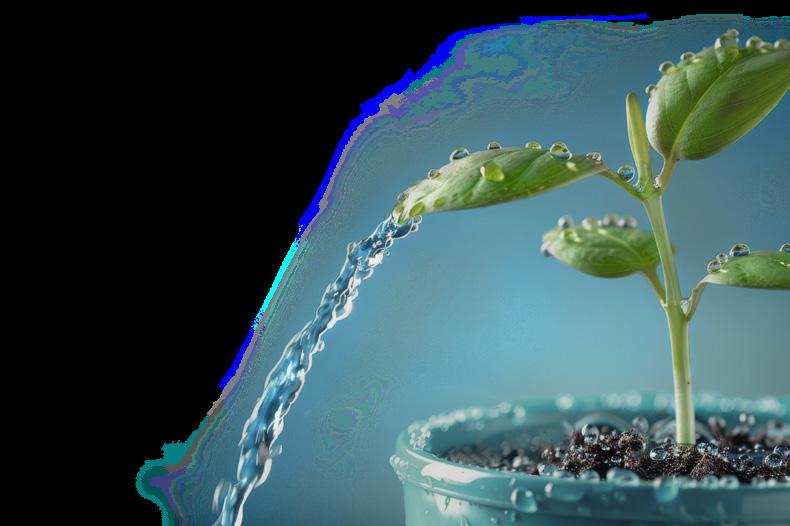
TRIACONTANOL
53




Application, Assimilation, and Fate
Tracking down triacontanol at your local hydroponics and indoor gardening store might be more complex, depending on your local regulatory environment

A little triacontanol goes a very long way! Around 0.1 mg/L or 0.1 PPM is considered an efficacious dose for root feed.
When triacontanol is root-fed, its fate within the plant system is primarily determined by its role as a plant growth regulator and its physicochemical properties:
1. Absorption and Translocation: Triacontanol is absorbed by the roots from the growing medium. Once inside the root cells, it can be translocated through the plant’s vascular system, particularly the xylem, which transports water and soluble mineral nutrients from the roots throughout the plant.
2. Physiological Effects: As already mentioned, triacontanol can promote various physiological responses once inside the plant, such as increasing chlorophyll content, enhancing photosynthesis, stimulating the production of proteins and nucleic acids, and improving the efficiency of nutrient usage.
3. Growth Promotion: These physiological effects contribute to the overall growth promotion observed in plants treated with triacontanol, such as increased root and shoot biomass, larger leaf area, and sometimes earlier or more abundant flowering and fruiting. Note that some studies have also found that the effect of triacontanol can also be enhanced by additional magnesium. (Moaaarrrr calmag!)
4. Metabolism: Like other plant-derived compounds, triacontanol undergoes metabolic processing within plant tissues. The exact pathways and transformations are not extensively detailed in scientific texts. However, it is postulated that it could convert into various compounds, potentially impacting plant growth and morphogenesis.
5. Residual Fate: Given triacontanol’s organic origin and affinity for fats, it will likely integrate into the plant’s waxy surface layer or other fat-rich structures. Its susceptibility to biological decomposition implies a reduced likelihood of remaining within plant tissues or the environment over an extended period.
6. Harvest and Quality Effects: Triacontanol has been observed to have implications on the harvest’s attributes, potentially amplifying yield.
Growers typically start incorporating triacontanol into their nutrient regimes at the beginning of flowering once actual flowers emerge. While some triacontanol-containing bloom additives recommend use throughout the flowering period, many growers discontinue use by week five or six of flowering.
So—in summary—a little TRIA goes a long way! Use it as a root feed for the first four or five weeks of bloom and then discontinue. 3
BIO Everest Fernandez is a well-respected industry educator, veteran hydroponic grower, and grow light enthusiast based in France. He works primarily as a marketing and cultivation consultant and was the founding editor of Urban Garden Magazine in the UK, US, and Canada. He also writes and researches for the popular hobby horticulturist YouTube channel, Just4Growers
5555
TRIACONTANOL
unicorn Hypochlorous Addressing the in the Room


BY AV SINGH 56
Unequivocally, the best-kept secret that many people have been shouting about for over 190 years is hypochlorous acid (HOCl). Commonly referred to as “Electrolysed Water”, HOCl is an aqueous solution with concentrations that range from 1000 ppm to as low as 1 ppm and ideally has a near-neutral pH. This simple compound that includes hydrogen, oxygen, and chloride can address everything from powdery mildew and smelly shoes to SARS-CoV-2, acne, the eggs of spider mites, and even bad breath!
Not all hypochlorous acids are created equally...
HOCl has never been registered as a pesticide or a fungicide; instead, widespread testimonials have witnessed its efficacy in many pests and pathogens, plant health, and vigour. More likely, HOCl is commonly registered as a disinfectant. The “magic” behind this unicorn transcends agriculture and is routinely used in hospital sanitation, wound irrigation, cosmetics, and the industrial cleaning of commercial spaces.
More Stability
Despite HOCl being discovered in 1834 and recognised as one of the most potent and safest disinfectants, it has yet to receive favour over other products like isopropyl alcohol and bleach due to its lack of stability. In years past, manufactured HOCl generated from the electrolysis of water containing either noniodised salt (NaCl) or hydrochloric acid (HCl) would quickly revert into its component parts, making it ineffective. Proprietary technologies have now created HOCl solutions at various concentrations that can be shelf-stable for over a year. The variability in shelf stability highlights one of the other reasons why HOCl has not garnered widespread acceptance, as not all hypochlorous acids are created equally. People wrongly assume that all HOCl is the same. HOCl in an aqueous solution can have a wide range of pH and purity (i.e., removing much of the NaOH - sodium hydroxide), which can have a bearing on its stability and ability as a disinfectant.
The Rumour Mill
can penetrate plant cell walls and enter cell membranes to exert bactericidal effects on pathogens while causing little or no harm to plants and humans.
All Mammals Produce It
When we consider using chemicals as disinfectants or pesticides, we tend to think of these created by people wearing white lab coats and appropriate PPE (Personal Protective Equipment). Ironically, HOCl is something all mammals produce as a first line of defence against pathogens. White blood cells (neutrophils) chase down invading pathogens, releasing chemicals like the most powerful oxidising agent—HOCl. HOCl produced in our bodies remains stable for seconds but can kill bacteria, fungi, viruses, and perhaps even viroids in plants.
This simple compound that includes hydrogen, oxygen, and chloride can address everything from powdery mildew and smelly shoes to SARS-CoV-2, acne, the eggs of spider mites, and even bad breath!
Even more exciting about all mammals producing HOCl is that in appropriate concentrations, many of the beneficial microbes we find on our skin, mouths, and gut microbiome are not impacted by HOCl. Many beneficial microbes are the same as those found in and on our plant leaves and soil. For example, gram-positive endospore-forming beneficial bacteria like Bacillus subtilis are not killed by HOCl when using recommended rates and contact time. This suggests that growers and gardeners seeking the benefits of microbes associated with nutrient cycling and plant protection can use HOCl in moderation.
HOCI in the Garden
Misleading information is another major factor that has limited HOCl from being recognised as a disrupter technology. Many have concluded that HOCl in water is no different than a sodium hypochlorite (NaClO) solution, a common bleaching agent. They do not consider that bleach contains harmful chloramines and stabilisers such as sulphates and phosphates that promote algal blooms. Stable HOCl remains as HOCl, while in contrast, NaClO will dissociate into having hypochlorite (ClO-) ions which can be very corrosive to humans and metals. Interestingly, many argue that the disinfectant efficacy of bleach comes from the presence of HOCl. The electrical neutrality of HOCl, especially when designed to have a near-neutral pH,
The myriad uses for HOCl in other sectors, such as personal, health, and dental care, are ever-increasing. However, agriculture is the focus of this article, and I am sharing information gained through personal experimentation, anecdotal observations, and communication with other growers. Although not a paid advertorial, my comments are based on five Canadian HOCl products registered as disinfectants, foliar fertilisers, fruit and vegetable washes, or cleaners and descalers.
Most adopters of HOCl are initiated by using it in their sanitation programme, but it’s not an easy entrance. For many growers, the notion that “something non-toxic is going to disinfect better than something toxic” is hard to swallow.
57
HYPOCHLOROUS ACID
57

Hypochlorous acid, when generated at pH neutral, is that magical unicorn that shows promise to revolutionise disinfection and, to some extent, cultivation practices, safeguarding crops and consumers alike

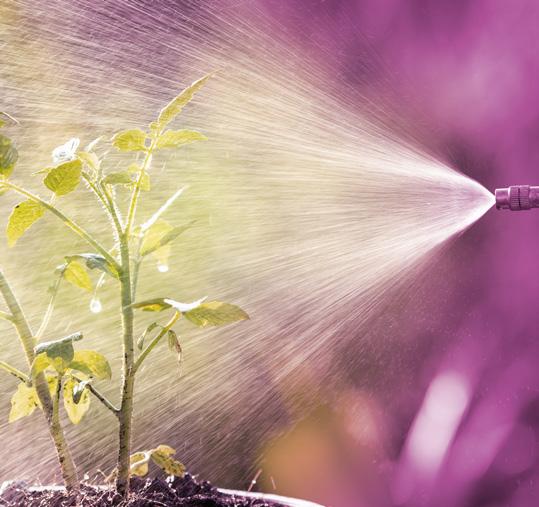
For many growers, the notion that “something non-toxic is going to disinfect better than something toxic” is hard to swallow
However, the efficacy, albeit vastly superior to alcohol, quaternary ammonium, bleach, or hydrogen peroxide, is not the only factor in their decision. The safety of their workers plays a significant role in choosing HOCl. In contrast, with products like alcohol and bleach, HOCl requires no PPE and leaves no residue or odour. The contact time for most pathogens is relatively short, so using a fogger or mister works well. There is no safety issue as one might have with an electrostatic sprayer and isopropyl alcohol.
Moreover, several scientific papers claim HOCl does not appear to cause pathogens to mutate, like bleach, alcohol, or hydrogen peroxide. This may lead growers to use HOCl to help slow the mutation of plant pathogens. Within the realm of sanitation, HOCl is more readily accepted as an irrigation and filter cleaner, removing biofilm and scale deposits. Many hydroponic, aeroponic, and deep-water culture systems titrate low concentrations that keep fertigation lines clean and provide root protection, allowing for healthy roots.
HOCI on Seeds and Cuttings
The less chartered waters for HOCl, and frankly more interesting than surface sanitation, is what growers and gardeners worldwide have been experimenting with by using HOCl on plants. For some growers, HOCl starts with the seed or the cutting (clone). Low concentrations as a seed soak help reduce pathogens that may have established, like fusarium or botrytis, while having minimal impact on the beneficial seed microbiome. Similarly, in clones, HOCl helps oxidise the wound from the cutting action and reduces the probability of
infection. It is important to note that chloride is also an essential element that can help drive good vegetative growth.
Exciting Rewards
Perhaps an expanded interpretation of the fruit and vegetable wash label or using HOCl as a foliar fertiliser, several growers use HOCl as a prophylactic mist throughout the growing cycle and are reaping some exciting rewards. Expectedly, diseases like powdery mildew and botrytis are non-existent, but many growers have noticed fewer pests like aphids, thrips, fungus gnats, and spider mites. Most interestingly, testimonials stating shorter growing cycles and increased flavour and aromas (terpenes) have been commonly reported. Mushroom growers mist cultivation rooms, growing media, and mature fruiting bodies to establish a sterile environment and prolong shelf-life.
Magical Solutions
As a non-mainstream agronomist, you get accustomed to being presented with some truly “magical” solutions that would be game-changers, only to be frustrated by people unwilling to try an alternative but still complain about the dysfunctional status quo. Hypochlorous acid, when generated at pH neutral, is that magical unicorn that shows promise to revolutionise disinfection and, to some extent, cultivation practices, safeguarding crops and consumers alike. 3
Av Singh, PhD, PAg is an advocate of regenerative organic agriculture serving various organisations including Regeneration Canada,
5959
HYPOCHLOROUS ACID
Bio
Navdanya, and the Canadian Organic Growers.
BY MARTYNA KROL

A Fungal Revolution A Fungal Revolution
PHOTOS: MAX MUDIE 60
The world has undergone a true fungal revolution in the last few years, accelerated mainly by the Netflix production ‘Fantastic Fungi’. Like mushrooms popping up after the rain, we see brands offering medicinal products and local growers turning empty rooms into fruiting chambers. We enjoyed listening to Merlin Sheldrake’s captivating voice as he described the world’s wonders beneath our feet, and we’ve witnessed discoveries by Paul Stamets and his engaging reels.
Max Mudie is my favourite ‘myco-persona’ of the United Kingdom, offering an intimate glimpse into the microscopic world through his stunning macro photography. Hidden behind his catchy Instagram handle, allthingsfungi, Mudie presents tiny mushrooms under magnification, revealing vibrant colours, intricate textures, and shapes that genuinely transport us to an otherworldly realm. While many of us perceive the fungal kingdom as nothing more than brown, slimy, odd-looking, fruiting bodies, Mudie’s photographs reveal a world of intricate details and beauty, a universe unfolding beneath the surface.
Spores of Wonder
Mudie first encountered the fascinating world of mushrooms 20 years ago. In those early days, he would cycle through the countryside, spotting peculiar dotted fungi that piqued his interest. Information about mushrooms was scarce then, and nothing he found satisfied his curiosity.
He eventually moved to a rural area teeming with mushrooms, and his background in photography proved fortuitous. After all, the best way to identify any specimen is to take a picture and examine it closer. Little did Mudie know that his mushroom photography would be magazine-cover-worthy one day, and thousands of followers would appreciate his discoveries.
Mudie’s approach to his newfound passion was one of hyperfocus, a trait shared by many in the mushroom enthusiast community. Fortunately, he has access to habitats where mushrooms thrive, and he’s observed them keenly over the last six years whenever he’s not at work.
This immersive journey has led to encounters with individuals willing to mentor and guide him, including Iona Frazer, a mycologist with nearly two decades of experience teaching identification in the Ash Downs region of Sussex. Together, they ventured into numerous forays in the area, rubbing shoulders with experts capable of naming 20 species of fungi growing on a single nettle stem. Despite everything he’s learned over the years, Mudie remains humble.
Mudie encountered these creatures while exploring the microscopic depths, and he was instantly captivated by their incredible beauty
Foray: A foray is an outing or expedition, typically to search for or study something in its natural environment. In mycology, a foray refers to a trip taken by mushroom enthusiasts into the outdoors to hunt for, identify, and observe various fungi species growing in the wild.
“The more I’ve learned, the less I feel like I know about it,” he admits.
His pursuit was never about science or mycology; it was pure play, a childlike exploration of the natural world.
“Being observant is the best thing you can do,” he says. “Notice things. When you’re a kid, you have that sense of wonder, which feels amazing. As you grow older, you lose that. But it’s all still there; all you need to do is look at things, especially through the lens of magnification.”
Mycology - A Passion, Career, or Both?
While Mudie has not yet had any groundbreaking discoveries, he has been meticulously testing some promising samples. Further DNA sequencing and analysis are required to confirm their novelty. Meanwhile, the mycological community eagerly awaits the results.

61
61 A FUNGAL REVOLUTION


Hidden behind his catchy Instagram handle, allthingsfungi, Mudie presents tiny mushrooms under magnification, revealing vibrant colours, intricate textures, and shapes that genuinely transport us to an otherworldly realm
Experts estimate that a staggering 90% of fungi species have yet to be identified and catalogued, with a mind-boggling 1.5 billion species potentially existing worldwide, including rusts, yeasts, smuts, and moulds.
Alas, the field of mycology needs more funding, and its devotees often pursue their passion outside their regular employment. Mudie juggles a full-time job paying the bills while dedicating his free time to studying and appreciating fungi. He has also co-founded Petrichor (aptly named after the earthy scent that permeates the air after rainfall), which aims to conduct surveys at Sites of Special Scientific Importance. Recently, Petrichor spent three days meticulously studying grassland fungi, a pursuit that yielded an extraordinary discovery: four species previously unknown to science. Although they did not directly observe the fruiting bodies, soil analysis revealed their presence.
Beyond their research, Petrichor is committed to making their knowledge accessible to the public. They offer fungi and plant identification teaching sessions, ecology surveys, and microscopy services. Moreover, they aim to harness the restorative power of nature by conducting sessions focused on mental health and rehabilitation through building a connection with the natural world.

Fungi Everywhere
The wonders of the fungal kingdom are everywhere. Mudie recalls visiting a friend in Brighton, where, despite having only a modest 2x3-metre courtyard, they found two species of fungi and a slime mould thriving.
“If we can find it in the centre of Brighton, everyone can find it. Nature finds a way,” Mudie says.
Mudie fervently advocates bringing these natural marvels into one’s home. He encourages enthusiasts to collect organic materials, such as leaf litter or bark, and incubate them in moist conditions; the chances are high that something will grow.
For those truly dedicated to pursuing mycology, Mudie suggests collecting herbivore dung and watching the coprophilous fungi (those that thrive on dung) sprout. But for anyone seeking a more accessible introduction, observing the daily transformations within a leaf and bark setup can be equally captivating. It reveals the intricate world of springtails, mites, and the eventual release of spores back into their natural habitats.
Once the initial fascination takes hold, Mudie recommends connecting with a local mycological society, immersing themselves in a community of like-minded enthusiasts and seasoned experts. Within these societies, individuals often specialise in particular areas, such as ascomycetes or microfungi. In contrast, others focus their studies on heart rot fungi, brackets, or even the enigmatic universe of slime moulds.
6363
A FUNGAL REVOLUTION
Mycena acicula


GREAT FLOWER COMES FROM POWDER












CRAFT
BASE
ADITIVES Distributed in the UK by
POWDER
NUTRIENTS &

Slime Moulds
He
encourages enthusiasts to collect organic materials, such as leaf litter or bark, and incubate them in moist conditions; the chances are high that something will grow

While many have become familiar with fungi, Mudie’s fascination extends to the lesser-known yet equally fascinating realm of slime moulds. These peculiar beings, classified as amoeba-protists (single-celled organisms), are an entirely separate mushroom entity. Initially drawn to the study of microfungi, Mudie encountered these creatures while exploring the microscopic depths, and he was instantly captivated by their incredible beauty. Leaning on his background in photography, he began capturing them in exquisite detail, revealing a world often overlooked.
Estimated to encompass approximately a thousand species, the diversity of slime moulds is nonetheless dwarfed by that of fungi, with many more species awaiting discovery. This area remains understudied despite the possibility that slime moulds play more significant roles in their ecosystems than we know.
Like their fungal counterparts, slime moulds create sporocarps and release spores, but the similarities essentially end there. The life cycle of a slime mould begins with spores released from a fruiting body. These spores then transform into myxamoebae or flagellated cells, undergoing intricate fusion processes that eventually form the plasmodium – the mobile, creeping stage that forages across the forest floor. Some plasmodia are visible, while others remain hidden, appearing when conditions are favourable. During their forays, they exhibit a mesmerising phenomenon known as cytoplasmic streaming, wherein fanlike projections extend from the organism’s leading edge, their movements visible both at the periphery and through the pulsing of the interconnected tubular networks.
Additionally, myxamoebae or flagellated cells contribute to the intricate soil food web, raising fascinating questions about the role slime moulds possibly play within the soil even before forming their distinctive plasmodial stage. Once the plasmodium emerges, it creeps across forest floors, feeding on bacteria and fungi while providing a habitat for numerous invertebrates.
Slime Mould and the Cosmos
In Japan, researchers are actively investigating the potential medicinal properties of slime mould’s chemical compounds. Even NASA has harnessed the remarkable capabilities of these organisms, employing them to help map the intricate filamentary networks of dark matter throughout the universe. By studying the efficient ways in which slime moulds aggregate and form complex networks to locate food sources, NASA scientists have developed algorithms that aid in charting the largest-scale structures of the cosmos.
Many have heard the intriguing tale of how Japanese researchers used slime moulds to assess the efficiency of their underground rail network. Remarkably, the slime mould constructed a strikingly similar pattern within a mere 24 hours, confirming the decency of the existing infrastructure. So captivating are these creatures that they have even inspired a slime mouldthemed wristwatch, akin to the once-popular Tamagotchi digital pets, where the wearer must maintain optimal conditions for the watch to function.
6565
Arcyria slime mould
A FUNGAL REVOLUTION
Mycena

Meet Slimon
Among Mudie’s most cherished companions is Slimon, his pet slime mould that continues to provide endless entertainment. Slimon’s precise species remains a mystery; a slime mould’s identity can only be reliably determined once it matures.
This process requires a meticulous examination of microscopic characteristics, such as spore size, ornamentation, and the intricacies of the peridium. The peridium is the delicate structure that ruptures to release the spores, revealing further clues about its identity in the form of the capillitium, a network of threads that supports the spore mass.
Even with such scrutiny, accurately identifying a slime mould can prove elusive. Mudie points to Flammulina, a genus of fungi commonly known as the Enoki or Velvet Shank mushrooms. British mycologists lumped multiple species under Flammulina velutipes for ages, only for taxonomists to subdivide the group into six distinct species.
“We’ve been misidentifying things in the UK for a long time based on morphological features,” Mudie acknowledges.
However, with the advent of advanced techniques like DNA sequencing and PCR technology, our understanding of this complex world is rapidly improving. The world of mycology continues to reveal its boundless wonders. As Mudie and his fellow mycophiles forge ahead, their unwavering dedication and childlike sense of awe promise to unearth discoveries, rewrite our understanding of the natural world, and cultivate a deeper appreciation for what it offers. 3
Experts estimate that a staggering 90% of fungi species have yet to be identified

Mycophile: A mycophile is a person who loves or is interested in fungi, including mushrooms, moulds, and yeasts. Mycophiles are passionate about studying, collecting, photographing, and learning as much as they can about the amazingly diverse fungal organisms found in nature and
 BIO Martyna Krol is a vegetable grower, natural beekeeper, and edible spaces designer. She is a lover of all soil and urban farming techniques and is the former head of growing at Incredible Aquagarden.
BIO Martyna Krol is a vegetable grower, natural beekeeper, and edible spaces designer. She is a lover of all soil and urban farming techniques and is the former head of growing at Incredible Aquagarden.
A FUNGAL REVOLUTION


SPARK YOUR PLANTS TO NEW HEIGHTS




HIGH CONCENTRATION = FASTER INOCULATION AND POTENCY
3600 endomycorrhizal propagules/g
Beneficial bacteria including Mycorrhizae Helper Bacteria (MHB)
Growth enhancers & biostimulants


WHAT IS MYCORRHIZA?
Symbiosis between fungi (myco-) and plant roots (-rhiza)
Assists 90% of plant species
Exists for 400 million years, known for 150 years, extensive research over 50 years
Effectively extends (10-100X) plant root system
Obligate mycotroph plants, require mycorrhizae to grow optimally
Rarely found in commercial growing media



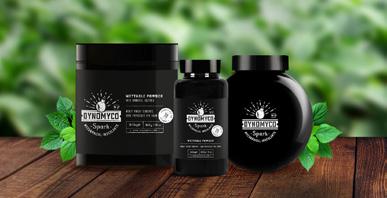
a unique blend of mycorrhizae, Mycorrhizae Helper Bacteria (MHB), and biostimulants - supports plants throughout the entire growth cycle. With mycorrhizae underpinning your rhizosphere, beneficial bacteria availing nutrients for your plants, and bio-stimulants enhancing growth, DYNOMYCO Spark gives your plants a head start with ongoing benefits.
HIGH CONCENTRATION = FASTER INOCULATION AND POTENCY
3600 endomycorrhizal propagules/g
Beneficial bacteria including Mycorrhizae Helper Bacteria (MHB)
Growth enhancers & biostimulants


THE DYNOMYCO® DIFFERENCE

BEST OF BREED
World's leader in Mycorrhizal production
Decades of R&D

DYNOMYCO Spark's unique wettable powder formula is easy to use. It is designed for use as a drench or in irrigation systems with a filter size greater than 250μm (less than 60 mesh).
WWW.DYNOMYCO.COM
Medical Cultivar S27 - Weight (g) 87 88 89 90 91 Untreated DYNOMYCO Spark Average Dry Weight per Plant (g) Basil Yield (LTD454) 100 110 120 130 140 150 DYNOMYCO Spark Untreated Yield Weight (g) TRIAL TRIUMPH: A CLOSER LOOK AT OUR RESULTS LET’S BE BEST BUDS! CONTACT US FOR TRIALS, SAMPELS & INFORMATION




In September of 2023, the inaugural All Things Fungi Festival took place in the ancient woodlands of West Sussex, providing a much-needed platform for those legitimately working in mycology. The event gathered prominent enthusiasts, offering a timetable brimming with nerdy talks, artistic explorations, healing sessions, and beautiful evening entertainment, including a DJ session featuring a mushroom connected to the sound system, throwing some spacey tunes. This year, the event promises to be even bigger and better, jam-packed with immersive experiences catering to every level of mycological curiosity.
The festival grounds offer a mesmerising opportunity: an ancient woodland habitat tended by a custodian keen on protecting and rewilding the area. The event’s agenda is diverse and engaging, featuring numerous forays led by expert tutors, providing opportunities to identify mushrooms in their natural habitats. Attendees can look forward to various artistic and musical offerings, all with a distinct mycological focus. Guided UV walks, UV henna tattoos, microscopy sessions, and DNA sequencing demonstrations promise to unlock a world of hidden wonders. Professional mycologists will also give a series of talks.
This year, the event promises to be even bigger and better, jampacked with immersive experiences catering to every level of mycological curiosity
Citizen Science
For those unable to attend, remember that pursuing mycology is a yearround endeavour, transcending the traditional “mushroom season” when fungi are most prolific and edible varieties abound. By venturing into the great outdoors, experimenting, and making careful observations, amateur naturalists can contribute invaluable data to professional mycologists.
Festival Sunday will be dedicated to families this year, welcoming those under 18 to inspire and engage the next generation of mycologists. Many of today’s most prolific palaeontologists can trace their passion to the awe-inspiring Jurassic Park film, which ignited their youthful imaginations and propelled them toward groundbreaking discoveries. With this in mind, Sunday’s activities will be tailored to captivate young minds, bringing a love for the natural world through kid-themed explorations and hands-on experiences.
Representing all facets of the fungal kingdom, from soil health to mental well-being, the All Things Fungi Festival aims to educate and further the cause of science and facilitate groundbreaking discoveries.
By utilising distribution apps like iRecord, iNaturalist, or the more hardcore FRDBI (Fungal Records Database of Britain and Ireland), individuals can help build a comprehensive understanding of fungal distributions and diversity. As more people engage with these platforms, contributing data and moderating content, these tools’ algorithms become increasingly refined, providing accurate identifications and insights.
The 2024 edition of the All Things Fungi Festival takes place September 13-15 in West Sussex, UK. For more information and to book your tickets, go to: allthingsfungi.co.uk.
6969 ALL THINGS FUNGI FESTIVAL

An Easy Way to Grow at Home


70
BY ALEX FIELD
Oyster Mushrooms
Oysters are among
the easiest mushrooms to cultivate at home
Oyster mushrooms will boost your culinary game. They’re versatile, tasty and loaded with vitamins, minerals and antioxidants. They’ll flourish on your kitchen counter or garden with a few simple ingredients – in under four weeks from start to finish. You’ll likely get multiple ‘flushes’ of mushrooms from the same container, too. Introducing “Bucket Tek”!
Why Oyster Mushrooms?
Oysters are among the easiest mushrooms to cultivate at home. They’re hardy, fast-growing and not picky about their food source or growing conditions. They’ll grow happily on straw inside a bucket with holes in the side – the mushroom clusters will grow out of these when ready.

How does it work?
In nature, mushroom spores germinate on something nutritious –like soil, a dead tree, or manure. Throughout the summer, mycelium will spread through that area (usually turning it white). When it’s fully ‘colonised’ in the autumn/fall, mushrooms will grow out of it to spread their spores; this is what we’re replicating with “Bucket Tek”:
1. Introducing mycelium to a warm, wet ‘underground’ space to colonise inside a bucket.
2. Changing to a cooler, humid ‘fruiting’ stage where the mushrooms appear.
Which Oyster to Grow?
Any ‘side-fruiting’ oyster will work using this method. Pink and Yellow oysters grow well in hotter climates, while Grey/Blue Oysters do better in cooler places. Avoid King oysters, as they like to grow on a flat surface.
Oyster mushrooms will boost your culinary game. They’re versatile, tasty and loaded with vitamins, minerals and antioxidants
What will I need?
INGREDIENTS
• Oyster Mushroom Grain Spawn - This is the equivalent of mushroom ‘seeds’; a quick Google search will find many options. 100g is enough for a 10-litre bucket, but you can use more if you want to.
• Straw - This is the ‘substrate’ or ‘soil’ from which the mushroom mycelium will eat and grow. Chopped straw is best, although any will do. Pet shops are a good place for this.
• Gypsum (optional) – Also known as calcium sulfate, this adds nutrients for a better harvest. If you use it, aim for around 5% of the dry weight of the straw you use.
• Boiling water – for pasteurising straw.
EQUIPMENT
• A mixing container – This can be a large cooking pot with lid or a PP5 plastic bucket with lid.
• A large metal spoon
• A container for growing in – A plastic bucket with a lid, a well-washed yoghurt pot or any other solid plastic container.
• Drill – This will make the holes the mushrooms will grow out of.

• Medical tape – This breathable tape will cover the holes while the mushrooms are ‘colonising’ (the ‘underground’ stage of growth).
• A spray bottle – to humidify your mushrooms as they grow.

71
71 MUSHROOM GROWING
Grain spawn











































CANNA RHIZOTONIC












At CANNA Research, we are continuously testing our products in order to make improvements. In May 2024, RHIZOTONIC will be getting an upgrade! When using the improved product you will experience increased effectiveness and tank stability. The shelf life has doubled from one to two years and you no longer need to worry about raised pH levels in your tank when applying the product. For growers, who were using RHIZOTONIC before, rest assured you will not need to change the way you use it and you can still expect exceptional results from your plants.










How to do it
Pasteurising Straw
1. Pour your straw into a clean mixing container.
2. If you are using gypsum, add it to the straw.
3. Add boiling water and mix to cover the straw. Leave the whole thing to cool.
4. Drain the excess water from the container when it’s back at room temperature.
Preparing Growing Container
1. Drill 12mm holes 4 inches apart around the outside edges of the growing container. A little smaller will work if you don’t have a drill bit that big.
2. Cover each hole with medical tape.
3. Drill several tiny holes in the bottom of the bucket for drainage – leave these open.
Mixing in the “Seeds”and the “Underground” Phase
1. Massage your grain spawn through the bag to separate each grain.
2. With clean hands, put a layer of the prepared straw in the bottom of your container.
3. Follow this with a scattering of grain spawn.
4. Make a ‘lasagna’ from layers of pasteurised straw and grain spawn until you have filled the whole container.
5. Put on the lid and leave in a warm, dark, and relatively clean place for two weeks. A good temperature range is 21-24°C (70-70 °F), but each strain will have its favourite colonisation temperature, so check you’re meeting its requirements.

The “Overground” Phase –Growing Mushrooms!
1. After two weeks, open the container and ensure the whole surface is white. If so, it is time to put your container into “fruiting” conditions.
2. Remove the medical tape from the holes and move your container into a cooler place in daylight to encourage the mushrooms to grow. This can be inside or outside – out of direct sunlight.
3. Keep the outside of the bucket humid by misting it with a water sprayer a few times a day. If you live in a dry place, you can spray the inside of a plastic bag and put it over the container to create a humidity ‘dome’. Make sure to remove this regularly to introduce fresh air and extra humidity.
4. After a few days, you will hopefully see baby mushrooms appear in the holes. Around five days after this, your mushrooms should be ready to harvest!
7373 73
Pasteurising the straw
Layering straw and grain spawn
Substrate ready for fruiting
Making holes in the bucket
MUSHROOM GROWING
Taping over the holes




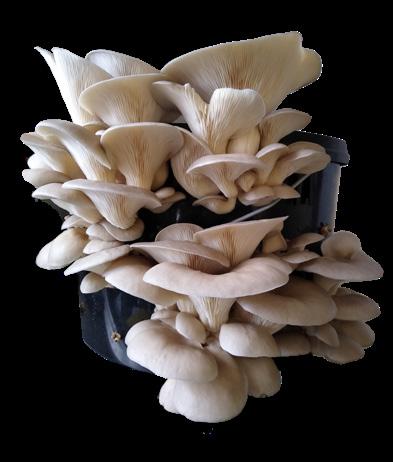
– And Getting a Second Flush
1. Your mushrooms are ready when the edge of their caps flatten or turn upwards.
2. To harvest, grab a cluster and gently twist it until it comes away from the container. You can harvest mushrooms when they are ready.
3. When you have harvested your bucket, rehydrate it – soak it in a bigger bucket of water for around four hours – and then return it to fruiting conditions for the next “flush”. You may get many “flushes” of mushrooms from one bucket.
Enjoy!
Always cook before eating. Oysters are excellent in soups and stews or torn into strips and fried. For a more succulent mushroom, broil them in a bit of water until the pan goes dry – and then throw in some oil to crisp them up on the outside.
If you have too many mushrooms to eat right away, you can store them in a plastic tub with the lid open in the fridge. If you want to preserve your harvest, you can dry them in a dehydrator until cracker-dry, then store them in an airtight container for when you want to rehydrate.
A warning for the big growers – if you intend to cultivate lots of oysters, it’s a good idea to ventilate your fruiting space, as Oyster spores can cause aggravation if inhaled. Large-scale growers use some kind of “fruiting chamber” to achieve optimal conditions in a closed environment – and remove spores using an extractor fan. 3
BIO Alex, the founder of Fungi Tribe, loves empowering people to grow their own food and medicine. He has taught over 6,000 students worldwide to cultivate mushrooms at home. For more information visit fungitribe.com or follow Alex on Instagram at instagram.com/fungi_tribe
Always cook before eating. Oysters are excellent in soups and stews or torn into strips and fried.


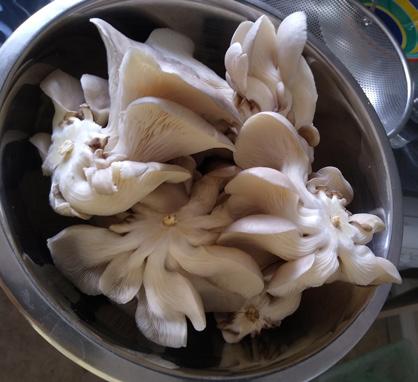
The
bucket harvest
MUSHROOM GROWING
7575 75


Notes From A Dirty Old Gardener
Garden Apathy
Iregularly get upset and, more often than not, emit an angst that most find unpalatable. The same can be said for plants with people. We have gotten so far from the navel of nature that we don’t even know what a rose smells like anymore. You have heard it in these articles on many occasions: my tomatoes taste like utter garbage, the bees are dying, and the salt on the highway is messing with my oregano. Welcome to Garden Apathy. Your post-coitus love affair with botany has turned sour; the soil is acidic. The old lover isn’t hitting those spots anymore, and the return on investment is dwindling. “Regi, this poetry has to stop,” said my editor never.
Feeling Hangry?
I don’t know if I am hungry or angry, but we all know it’s the same feeling. I am unsure whether it’s the upcoming spring toil or the fact I haven’t planted a seedling for the summer season that has my testicles in a bunch, but holy crap, am I feeling apathetic towards my garden. If you ever want to dismiss someone, tell them you feel “apathetic” towards them. You will destroy them. Apathetic is defined as the complete absence of interest or will to interact. Based on how my garden has reciprocated my love over the past few difficult seasons, I feel flagrantly and fastidiously apathetic towards my acre. I look outside to my land’s crusty corners without real excitement. Sounds like I haven’t shaken off the winter depression. I haven’t been shopping for nitrogen in months, and my crop is weeping for a parent with some resolve. Come on, old man! Find some courage and tell everyone something insightful or entertaining.
Like an absentee father, you simply plant the seeds in a random place that hasn’t proven viable and simply walk away like the stress of fatherhood is too much.
Shaking Things Up
Trying to stay excited in the garden is an everlasting battle. One way to remain dedicated and focused is new genetics. I got tossed a few UGOs (Unidentified Garden Objects) a while back that looked like spicy kidney beans. I’m curious, and it’s the one contender in my museum of oddities that has me interested enough to toil in any amount of shit and shrimp shell. A few years in the same location means I have a repertoire of plant runs I have to accomplish. Whether it be ass-blasting peppers or bushels of beautiful basil brewing in bounties of bubbling terpenes, I have to get out there. The damn tomatoes won’t grow themselves, and a poor apathetic gardener has got to eat. Jesus Christ, someone send me a Valentine’s card or something. I seem to have a zucchini-induced depression.
Regi’s absentee father analogy is what most people call chaos gardening. Give it a try! Read our feature article from the last edition:

Another way I am finding some motivation is by playing a game called “going out for a pack of smokes”. How do you play, you might ask. Well, it’s easy. Like an absentee father, you simply plant the seeds in a random place that hasn’t proven viable and simply walk away like the stress of fatherhood is too much. If, by some miracle, the bastard plant survives and produces fruit, I will be back in its life, like Amy Winehouse’s father after she became famous. No muss, no fuss. No babying the plant, no worrying about water or sun or college. If the little shit survives, then good. If not, then Papa has more shots to fire off. The pressure to have a bumper crop or general success in the garden often overshadows the pleasure we should get from it. Give it a try, plant the seed and walk away. Tell them you are going for smokes and don’t come back until they make something of themselves… the plants, I mean.
BY REGI ONETON 78
I regularly get upset and, more often than not, emit an angst that most find unpalatable.
Fun Projects
Mixing soil and tending beds isn’t the only thing you can work on in your slice of paradise. Start adding permanent garden features like rock gardens or permanent planters. If you are feeling brave, consider a tiny pond or birdbath. Last year’s garden could be leaving you underwhelmed and understimulated. So, take a break from the plants and work on their environment. It’s like organising the tools in the garage before you work on the next project or re-wiring the studio before you write the next album. Organising and building up your environment can help ease the garden apathy that grows in all of us.
Anti-Social Space
If you are anything like me, you don’t like seeing your neighbours. I don’t even want to look at you, let alone ask you about the weather. The probability of you asking me for a cup of sugar makes me anxious. They say tall fences make for good neighbours, and I agree. As an extension of building garden features, one should be a “quiet place” somewhere on the property or a small sanctuary enveloping you in a blanket of privacy. Create a privacy wall that grows perennially with a hammock or place a favourite chair next to a rock wall. Back in the day, I would see my grandfather sitting in the middle of a row in his garden, eating an orange. I thought he was nuts, but now I know he was just in his “quiet place”.

Finally, my friends, there is no shame in just saying “fuck it” for a season and taking up pickleball or something. Michael Jordan took a few seasons off to toss around a baseball before he returned to the NBA to win multiple championships. Taking a break and returning next year to slam-dunk some produce is okay. If there was a literary award for working Michael Jordan into a gardening article, I think this is a contender. Taking a
season off is like taking a break from a lover starting to get on your nerves. Perhaps the time apart will make you grow fonder. Pun intended. If the neighbours ask why you aren’t in the garden, have some fun with it. Tell them you are at war with the gophers on your land and are trying to starve them out this season or say the city has asked you not to garden anymore because you are making all the neighbours jealous. Simply telling them to kick rocks works, too. Well, my little bean sprouts, whether you get out there this season or not, remember to take a few deep breaths and enjoy the outdoors. Try planting like an absentee father. In any case, happy growing. 3
BIO Regi Oneton is a multi-disciplinary artist and daytime executive. He’s been a member of Socan since his first album release at the age of 20, and is a self-taught audio engineer and self-proclaimed studio rat. Regi is a late-blooming street artist and painter whose works can be found hanging in the offices of Burton and Vans Canada. Long-time contributor to the Under Pressure Graffiti Festival and lover of the Arts. As the years plow forward, he has added botanical enthusiast/plant father to his litany of passions. His interests include writing and spending too much time looking at his phone.
7979
NOTES FROM A GARDENER

Is there a silver lining when Trichoderma mould invades a mushroom cultivation project?
If At First You Don’t Succeed…
Trich Again?! Trich,Again?!Trich
Trich,
BY XAVI KIEF 80
Anyone who’s dabbled in mushroom growing has been warned: green Trichoderma mould, aka “trich” (rhymes with “bike”), is a crop destroyer. Get it out of your cultivation space, pronto, and improve sanitation protocols. You may as well write off any substrate contaminated by this aggressive species and absorb the loss.
I’ve seen aggressive enzymatic production, immune response and remarkable recovery despite Trichoderma’s presence on oyster mycelium-cultured blocks of grain. However, I’d never recommend resuming the harvest of mushrooms from quarantined samples. Doing so will almost certainly enshrine Trichoderma spores in the growing environment.
There is a reason why Trichoderma exists and why mushroom growers everywhere seem to encounter it. Consider consoling yourself by becoming familiar with some of the advantages of working with the mould in responsible cohabitation with the rest of nature.
If you’ve got Trichoderma riddled substrate on your hands, you can use it as a compost accelerator. In small quantities, you can merely add it to a kitchen composter or give it away to a friend or a neighbour whose veggie scraps could use a hand breaking down.
Urban community gardens are another good place to donate trich-laced grains. Often, these spaces are transitional and can use all the help they can get to restore and build living soil.
Making this connection with folks in your neighbourhood could be an opportunity to participate in a revised food and medicine supply chain, promoting resilience and supporting grassroots environmental education and wellbeing. You get to move the mould away from your clean rooms, people and pollinators (and others!) enjoy invigorated botanical spaces, and the trich itself gets to live where it’s appreciated. That’s a win-win-win!

What is Trichoderma ?
Trichoderma var. is a group of fungi prevalent in ecosystems worldwide. The ubiquity of these species results from co-evolution as incredibly beneficial partners of land plants. Powerful both in the soil and on the surface of growing vegetation, Trichoderma fungi are included in about 60% of registered biopesticides (Mukherjee 2013).
What does it look like?
Trichoderma forms a woolly-looking white structure. It does not mature to bear mushrooms but reproduces via bright green conidia (spore).
Why is it so common as a ‘pest’ in mushroom cultivation?
Mainly, it’s because Trichoderma appears almost everywhere. The standard protocols against all types of mould are generally considered the most effective against Trichoderma. We do not usually consider it an endophyte, persisting inside living vegetation. However, some species may pair with grain-bearing plants and be inherited as part of the seed microbiome. Pressure cooking and surface sterilisation should be enough to stop Trichoderma in its tracks, but more resilient types could survive a less-than-perfect sterilisation protocol and respond quickly to populate the nutrient-rich substrates and optimal growth conditions provided by mushroom growers.
Chemical treatments that destroy it are also unhealthy for the cultivated species, and some common disinfec tants are not allowed in organic facilities.


8181 TRICHODERMA
When you’re part of a cultivation campaign strategy team tasked with placing good actors in positions of influence, you could do much worse than Trichoderma spp.

We Like Trich
Remediating a Reputation
BY XAVI KIEF
82
Perhaps your mushroom substrate chose to write in its own candidate, or you’re not a fungi cultivator but know someone who is. The most obvious source of a well-connected Trichoderma culture is rapidly growing locally.
If you’ve ever tried the natural farming technique of collecting and developing Indigenous Microorganisms (IMOs), it’s safe to assume you’ve partnered with at least one type of Trichoderma.
Plant Growth Promoting Microbes (PGPM) are known to work in a consortium, and benefits are exponential when the plants themselves assemble the species through the call-and-answer of biochemical signals. Much of this activity goes on in the rhizosphere. Lab analyses of these wild collaborations consistently identify beneficial bacteria in the Bacillus and Pseudomonas groups in the mix, while Arbuscular Mycorrhizal Fungi (AMF) and Dark Septate Endophytes (another kind of fungi that live inside plant roots) also participate.
If you’ve ever tried the natural farming technique of collecting and developing Indigenous Microorganisms (IMOs), it’s safe to assume you’ve partnered with at least one type of Trichoderma
With this in mind, it’s wise to be humble and create conditions conducive to the garden plants’ recruitment strategies. Providing the least environmental stress and the greatest access to resources (non-chemical nutrition, water with a near-neutral pH, well-structured soil, good air circulation, and appropriate lighting) is a baseline for supporting the plant holobiont (see last issue) throughout its lifecycle.
In commercial or specialised settings where a single plant species or subtype is the primary focus and economic driver, specifically formulated PGPM preparations are an investment worth considering. A lot of work and money has gone into studying and selecting symbiotic species and strains while under the scrutiny of quality control and safety regulations in agriculture.
When selecting products that contain living organisms for crop inoculation, be familiar with the intended use, dilution ratios, application guidelines, and exposure/disposal instructions.
Campaign Promises: More Than Hot Air
For the last quarter-century, serious attention has been given to Trichoderma spp. as a potent ally in sustainable agriculture. Demonstrated areas of expertise include:
• Limiting damage by other fungi.
• Inducing plant growth.
• Improving nutrient availability.
• Increasing drought stress tolerance.
1. Displacing and Consuming our Competition for the Harvest
Trichoderma are exceptional mycoparasites. Investigations into the genetics of these species suggest they likely evolved from ancestors with voracious appetites for other fungi and arthropods. They boast a heightened aptitude for detecting and degrading chitin, the substance that makes fungal cell walls and insect shell walls so strong.
Trichoderma break down the protective outer structures of other fungi, decreasing their ability to proliferate through the soil and access food. They can sense the presence of potentially crop-damaging species in the rhizosphere and engulf and feed upon them.
Trichoderma are effective as a group because they display various tactics to gain favourable positions relative to available nutrition and space. Species specialise in making different types of secondary metabolites, which achieve similar aims but by varied courses of action. Trichoderma are better at disguising themselves from plants or share a secret passcode, allowing them to avoid generalist anti-fungal defence mechanisms. In the process, they displace disease-causing, resource-exhausting, immunity-stressing competitors.
Botrytis cinerea, the grey, plant-melting bane of strawberry, tomato, and many other valued crops, is inhibited by Trichoderma. So are many kinds of Fusarium, Pythium, Verticillium, and Pellicularis fungi, which cause blights, mildews, and rots.
Trichoderma are also known to repel the decomposers and the shredders (think nematodes and snails) in the root zone away from vital tissue, allowing plants to thrive undistracted by the need to repair damage and divert energy to immune-system responses.
2. Inducing Rapid Plant Growth
Robust roots and shoots of plants grow more speedily in the presence of certain hormones and other secretions. Auxins abundant in sea plants are one example of external sources that can supplement a garden. Trichoderma exude auxins and other organic compounds, which can directly benefit plant root development. Their presence contributes to greater branching of the roots, providing more surface area through which nutrients and water can be absorbed.
8383
TRICHODERMA






Discover the complete organic liquid range thanks to the new GK-Organics ® Florizon ! 100% organic fertilizers • www.gk-organics.nl distributed by: Check our new feed schedules:

3. Improving Nutrient Uptake Through Improved Solubility
One of the most important macronutrients for food and medicine growth is phosphorus. Even where it naturally occurs, the field may be considered deficient for farming because the phosphorus is bound up with iron and aluminium in acidic soils and calcium in alkaline soils. Research is ongoing but points to multi-step processes involving Trichoderma, which profoundly affect solubilising phosphorus and releasing it for plant uptake.
4. Improvements in Water Use and Drought Tolerance
Trichoderma are also known to repel the decomposers and the shredders (think nematodes and snails) in the root zone away from vital tissue
Trichoderma also show promise in the urgent call for better agricultural balance in water conservation. Their root growth-promoting benefits and participation in mechanisms that regulate water loss through leaves are pragmatic reasons to ensure Trichoderma species are available for plants to call upon in times of need.
No More Party Lines: How to Work with Trichoderma
Mushroom cultivation substrates hosting Trichoderma can be used most simply by breaking them up and adding them directly to compost piles or garden beds. Using mixed cultures such as these in already living, self-regulated growing environments is best.
Should you need to bulk up your supply, employ a more scientifically rigorous method involving microscopy and sterile techniques to isolate the trich from other organisms and food sources. Like in mushroom cloning of other targeted species, grow on a solid or liquid medium, and either dry or bottle the culture for later use. The viability of these products will vary depending on temperature, moisture, and length of storage.
Just as you would for any living organism, like seeds or spore syringes, it’s best to refresh supplies regularly rather than expect indefinite utility.
Kissing Babies, Shaking Hands: When Should Trichoderma Be Introduced to a Crop?
Some Trichoderma are reported to aid in dormancy-breaking and germination of seeds. You can start using PGPM inoculants from this early growth stage by surface-coating seeds with a dilute solution in powdered form or pre-soaking the planting medium.
The first transplantation of rooted cuttings or young seedlings is also a good time to perform a root dip, ensuring beneficials have the upper hand against damping off and other attacks. Root drenches with PGPM at regular intervals, particularly when plants are stretching and feeding heavily to grow flowers, fruits, or seeds, are also a good idea.

8585 85 TRICHODERMA


Can indoor growers use Trichoderma?
Growers in highly controlled conditions quickly discover the benefit of supporting rhizosphere PGPM, even in hydroponic setups. Cultivating resilience with non-destructive fungi like Trichoderma primes indoor gardens’ immunity responses rather than assuming all environmental management systems will always be optimised and 100% effective. An increase in root mass is generally associated with an increase in total bulk yield, while some of the metabolites from Trichoderma reduce the ratio of stalk/leaf: flower bud weight, improving totals for phytochemical harvest in a given area.
With intent and open minds, we can relegate good-fungi/bad-fungi politics to the past, look beyond one crop cycle, and collaborate with Trichoderma to survive and hopefully thrive in a shared regenerative future
Different ways PGPM can be used indoors depend on the irrigation system designs and type of substrate used, especially with soilless mediums (Rockwool or clay pellets, for example, by contrast to coir). Typically, hydroponic fertilisers are specifically formulated so that macro and micro-nutrients are bioavailable to roots without the help of microbes to unlock them from the soil. Diligent data collection and analysis relating to dosing are vital to ensure PGPMs and bottled foods are not being applied in excess, over-accumulating, or simply running to waste.
Serving Multiple Terms and Diverse Constituents
Trichoderma fungi are powerful dismantlers of molecules that contain environmental toxins. These activities are not found only in Trichoderma that have been previously exposed to these substances, but are innate to their ecosystemic roles. Though not considered an adaptation to survive the harshness of this specific type of contamination, Trichoderma persist and degrade several polycyclic aromatic hydrocarbons and chemical pesticides like glyphosate and DDT.
Their presence also lends effective action in drawing up copper and other metals from the roots of plants into the flowering heads. While this is not desirable for any intended consumer of those plants, it does remove those residues from the soil without requiring tillage and removal of the below-ground parts. Intentional plantings and harvest for non-food or medicinal purposes (fibre production, e.g.) may be part of a strategy to heal farmland and other sites of historical applications of chemical herbicides and insecticides.
Over the last century, we’ve learned much about good intentions (not to mention greed and desperation) when applying scientific innovation in agriculture. Wildcrafters and growers alike need to be judicious about the possibility that prior human interventions, lifestyle norms (like using leaded gas and paint) and even the disturbance of naturally occurring mineral sources may have created highly concentrated zones of toxicity.
Similarly, even though Trichoderma-based biocontrols are generally considered very safe for use, we should be wary as to whether industrial applications of any substance, whether at unnatural intervals or high exposure rates, pose a threat to the health of workers and locals. Checks for product allergenicity, infectivity, pathogenicity, and toxicity are done, but effects on immune system health are less often evaluated, and this remains a subject in need of greater inquiry. Findings from one study suggest that one Trichoderma-based fungicide used in cocoa production held the potential to cause damage to innate immune response systems in people. This research also raised the question of whether or not Trichoderma could be used in developing novel treatments relating to immunomodulation. It’s yet another reminder that the distinction between medicine and poison often comes down to dose.
8787
Trichoderma in test tubes

FEEDING PLANTS SMARTLY UPGRADE

A FERTILISER FOR THE ORGANIC GROWER WHO WANTS TO GIVE THEIR SUBSTRATE AN UPGRADE!
SLOWLY AVAILABLE NUTRITION




BACILLUS BACTERIA COLONIZE THE ROOTS






With this in mind, be careful when working with Trichoderma in volume, especially in powdered forms that can be more readily inhaled.
Learning from Our Missteps
Returning fertility to damaged ecosystems is a primary factor in improving food sovereignty and access to earth medicines. We must recognise the balance nature is always trying to find and align our goals with that harmony rather than attempt to dominate it. Unlike economically important crop plants, which command commercial attention and “pay the bills”, it’s easy to focus on acquiring and utilising isolated and “improved” versions of PGPM.
We must recognise the balance nature is always trying to find and align our goals with that harmony rather than attempt to dominate it
We Like Trich
Advances in genetic analysis prove no singular plant species thrives without its community of symbiotic microbes. We’ve learned from attempts at monoculture that fixating on the needs of only one varietal and bending the lived environment to suit its ideal cultivation parameters requires a lot more resources and can result in the establishment of vulnerable, easily destabilised populations.
References:
Thankfully, region-specific participatory plant breeding programmes and the rapid identification of unique phytochemicals (including those related to nutrient density and absorption, flavour, protein content, and antioxidant activity) are underscoring a cultural shift toward measuring yield and input efficiency through quality, not merely quantity.
Since trich are nearly everywhere we haven’t sanitised, it makes sense to expect and value the presence of subspecies locally adapted to abundantly producing and fertile regions.
Identifying, protecting, and working with PGPMs from nearby sources is one dimension of an intersectional strategy for land healing and future-focused environmental stewardship. With intent and open minds, we can relegate good-fungi/bad-fungi politics to the past, look beyond one crop cycle, and collaborate with Trichoderma to survive and hopefully thrive in a shared regenerative future. 3
• Ahmed, Heba & Al-Quraishy, Saleh & Hassan, Ahmed & Abdel-Baki, Abdel-Azeem & Abdel- Tawab, Heba. (2023). Biocontrol Potential of Trichoderma harzianum against the Land Snail Monacha cartusiana: Lab and Field Trails. International Journal of Agriculture and Biology. 30.10.17957/IJAB/15.2061.
• Guzmán-Guzmán, P., Porras-Troncoso, M. D., Olmedo-Monfil, V., & Herrera-Estrella, A. (2019). Trichoderma Species: Versatile Plant Symbionts. Phytopathology, 109(1), 6–16.
• https://doi.org/10.1094/phyto-07-18-0218-rvw
• Kakabouki, I., Tataridas, A., Mavroeidis, A., Kousta, A., Karydogianni, S., Zisi, C.,
• Jan, U., Feiwen, R., Masood, J., & Chun, S. C. (2020). Characterization of Soil Microorganism from Humus and Indigenous Microorganism Amendments. Mycobiology, 48(5), 392–398. doi.org/10.1080/12298093.2020.1816154
• Kouneli, V., Konstantinou, A., Folina, A., Konstantas, A., & Papastylianou, P. (2021). Effect of Colonization of Trichoderma harzianum on Growth Development and CBD Content of Hemp (Cannabis sativa L.). Microorganisms, 9(3), 518. doi.org/10.3390/microorganisms9030518
• M.T. Fernández-Sandoval, M. Ortiz-García, Galindo, E., & L. Serrano-Carreón. (2012). Cellular damage during drying and storage of Trichoderma harzianum spores. Process Biochemistry, 47(2), 186–194. doi.org/10.1016/j.procbio.2011.10.006
• López-Bucio, J., Pelagio-Flores, R., & Herrera-Estrella, A. (2015). Trichoderma as biostimulant: exploiting the multilevel properties of a plant beneficial fungus. Scientia Horticulturae, 196, 109–123. https://doi.org/10.1016/j.scienta.2015.08.043
• Lucilla Silva Oliveira-Mendonça, Érica Araújo Mendes, Julyanna Oliveira Castro, Mylene Melo Silva, Santos, A., Carla Martins Kaneto, Sandro Oliveira Dias, Ivan Bezerra Allaman, Vannier- Santos, M. A., Juneo Freitas Silva, Augusto, D. G., Oliveira, D., Santos, S., Kamila Pontes Lima, Maria Fátima Horta, George Rego Albuquerque, Cardoso, G., Jardim, S., & Lima, J. (2022). Trichoderma stromaticum spores induce autophagy and downregulate inflammatory mediators in human peripheral blood-derived macrophages. Current Research in Microbial Sciences, 3, 100145–100145. doi.org/10.1016/j.crmicr.2022.100145
• Mccoy, P. (2016). Radical mycology: a treatise on seeing & working with fungi. Chthaeus Press.
• Shahzad, R., Khan, A. L., Bilal, S., Asaf, S., & Lee, I.-J. (2018). What Is There in Seeds? Vertically Transmitted Endophytic Resources for Sustainable Improvement in Plant Growth. Frontiers in Plant Science, 9. doi.org/10.3389/fpls.2018.00024
• Yao, X., Guo, H., Zhang, K., Zhao, M., Ruan, J., & Chen, J. (2023). Trichoderma and its role in biological control of plant fungal and nematode disease. Frontiers in Microbiology, 14.
Xavi Kief is a writer, researcher, and lifelong learner with their hands in the dirt and their imagination traversing the universe. Seeking always to deepen and integrate their connection with the living planet and its diverse inhabitants, Xavi finds joy by infusing their practical and playful approach to cultivation with a healthy dose of science.They grow food and medicine for their family and community on their NorthEast Coast homestead.
8989
Bio


b r a n d N E W W E B S I T E
Local Growers
WHO’S GROWING WHAT WHERE
Wyreside Mushrooms Lancaster
It’s always nice to see a passionate personal interest turn into a profitable business and a wholesome lifestyle. Paul and Hayley collected their award for the Micro Business of the Year category in November of 2023, and yet, their customers harvested their first mushrooms only a year prior.
The business started in March of 2022, providing a tasty, healthy, and fun ingredient to people in Lancaster and Morecambe.


Paul has 20 years of experience growing mushrooms. When the lockdown ignited creativity, their kitchen filled with beautiful specimens of blue-grey Oysters and Lion’s Mane. Both Paul and Hayley are vegan, and mushrooms are a great protein-rich addition to their diet. The Lion’s Mane has all the umami flavours and a crispy texture with a soft middle when prepared as a steak on a hot pan. Once the pandemic madness was over, the taste of mushrooms lingered, prompting the creation of Wyreside Mushrooms to supply the local community. While working other full-time jobs, Paul and Hayley built and equipped the farm and started small-scale production.
Mushrooms differ significantly from plants, but the modern beauty of controlled-environment agriculture presents substantial financial opportunities in almost any space. Hayley mentions that it’s one of the coolest, most challenging, and most rewarding jobs. Things can sometimes go wrong, but with those challenges comes experience. Paul’s favourite aspect is connecting with like-minded people fascinated by mushrooms.
Their business focuses on benefiting the northwest coast by the river Wyre, which is the origin of their name. Hayley and Paul make face-to-face deliveries to Whole Foods shops and support the local food project Food Futures by providing cooking demonstrations of Oyster mushrooms to allow people to try the novelty ingredient. They like to connect with their customers and typically sell out within their small delivery radius.



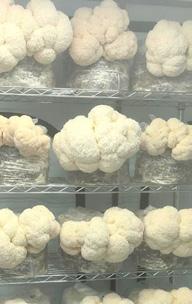
Sustainability and earth care are critical. To minimise waste, they started a WhatsApp group where surplus or unsold mushrooms are sold at reduced prices and ready for pickup straight from the farm. The waste products of mushroom cultivation are donated to a local organic farm to add to the soil biome.
Learn more: facebook.com/WyresideMushrooms @wyremush
BY MARTYNA KROL
in the UK & Ireland
9191
PRODUCT SPOTLIGHTS
















visit: GCmag.co/Product-Spotlight
Would you like to be featured as one of our local growers? If you’ve got a garden, grow room, or farm and have a story to share, contact us at: growers@gardenculturemagazine.com
Cary-Anne Hornsey Essex
Last year, during the All Things Fungi festival, I met an unusually charismatic lady who seemed to be practising some fancy plant-based witchcraft. I spotted her workshop, and indeed, the story of Cary-Anne Hornsey is as captivating as an old-school fairytale.

Her journey with plants began as a child; she lived in a cottage with an English garden, an orchard, and a pond. She spent many hours in the garden, making potions from all the plants, eventually deciding to pursue a career in herbal medicine and got a degree in homoeopathy. Throughout her studies, Cary-Anne realised the herbs she bought were growing in the wild. She developed a spiritual connection to plants, paving the way for her career.
Now, she grows herbs and vegetables at home. She quickly rewilded her suburban garden, using her foraging knowledge to incorporate medicinal weeds and allowing the seeds to spread throughout the space. Cary-Anne makes remedies with the plants she grows, calling her garden Nature’s Pharmacy. Her garden consultations focus on medicine, healing, and the client’s needs rather than what’s trendy. She usually encourages wild plants to grow and only pulls weeds once she knows what they are and their benefits. Often, low-maintenance plants like dandelions and yarrows are a great starting point.
Cary-Anne also believes in plant communication, meaning speaking to plants, asking them questions, and listening to what they have to say. You can read some words of wisdom in her upcoming book about foraging and folklore. It will be in the form of a 12-month foraging calendar with tables of plants to look for each month and accompanying potion recipes. The book also examines the magic and folklore of those plants. It will launch at the All Things Fungi Festival, where Cary-Anne will give a talk and run a workshop. If this is the year to acquaint yourself with something more profound, it’s the time to get a bit witchy; CaryAnne has some fantastic content to offer.




Learn more: foragegrowcreate.co.uk @forage.grow.create
93 WHAT’S GROWING ON

FAST. RESPONSIVE. BESPOKE.

WEB DESIGN
Designer A person who takes a problem and creates a solution. Developer Takes a design solution and builds a web experience. Business Is what comes to those who sell an experience.

WWW.NPK.MEDIA @NPK_MEDIA









Also available in ebooks
mamapublishing.com | cannascope.com
Pioneering References
WAYS
Mushrooms Help Boost Human Health
Are mushrooms a go-to in your kitchen? Extremely versatile, flavourful, and an excellent meat substitute, it’s no wonder they’re a culinary staple. What makes them even more appealing is that they pack a massive nutritional punch and are vital to keeping our bodies healthy and functioning correctly. Mushrooms are medicine! The health benefits seem endless, but we’ve narrowed the list down significantly for the sake of space. Enjoy our list of 5 Cool Ways Mushrooms Help Boost Human Health.
Vitamin D Superpowers
Did you know that mushrooms are the only food in the produce aisle containing vitamin D? This essential vitamin is typically produced by the sun and keeps us strong by helping our bones absorb calcium. Unfortunately, most of us don’t get enough vitamin D; our daily intake is far below the recommended amount. The Mushroom Council explains that mushrooms are unique from other foods because they can naturally increase their vitamin D levels through exposure to sunlight. As a result, mushroom farmers let UV light hit their crops during the growing process to increase vitamin D production. Varieties like crimini and portabella have higher levels of the plant sterol ergosterol, which converts to vitamin D when exposed to light. For example, a raw crimini mushroom grown under some light has 128% of the daily recommended value of vitamin D. We’re still huge proponents of getting vitamin D from the great outdoors, but why not get a little more by adding some mushrooms to your stir-fry, too?


Immune Boosting 2
There is no shortage of mushroom tinctures and capsules available at your local health food store, which you can use for daily immune support. Seriously, you’ll need some time to go through it all! These tinctures and capsules often contain five to seven different species of mushrooms, ranging from chaga, lion’s mane, and cordyceps to reishi, turkey tail, and more. Don’t feel like taking a tincture or capsule every day? Good nutrition plays a vital role in building our immune systems, and you can reap all the same benefits by enjoying mushrooms in your meals. Mushrooms are an excellent addition to your dinner plate because they’re low in calories and sodium and are free of fat, cholesterol, and gluten.They contain vitamin B6, copper, zinc, selenium, betaglucans, and more, protecting the body from infection against bacteria and free radicals. Incorporating these delicious gems into your weekly meal plan will help keep you healthy through the seasons and more than satisfied at dinner time.
Shiitake mushroom
1
Boost Gut Health 3
Dieticians are all about gut health, and for good reason. A healthy gut breaks down our foods and absorbs the nutrients so the body functions properly, improving overall health and mood. There are many ways to maintain gut health, and experts say eating mushrooms stimulates the growth of healthy bacteria in our bodies. According to UCLA Health, polysaccharides are the most abundant carbohydrate in mushrooms and pass through the stomach unchanged. As a result, they reach the colon and encourage healthy bacteria growth there. Mushrooms are high in fibre and contain prebiotics essential to a properly functioning gut. Reishi, chaga, coriolus, maitake, and lion’s mane mushrooms are excellent options to get the job done.

Cancer Prevention 5

Better Brains 4
We all have a lot on our minds, from obligations to family and friends to job performance, exercising, maintaining a home, and everything in between. Mushrooms can help clear the fog and keep our brains in working order. UCLA Health points to a study in Singapore that found that people who ate two cups of mushrooms a week were 50% less likely to develop mild cognitive impairment (MCI). MCI is considered an early sign of Alzheimer’s disease and causes issues with memory and language. Researchers offered study participants a wide range of mushrooms, including golden, oyster, shiitake, and white buttons. But when it comes to brain health, the lion’s mane mushroom is a shining star. With roots in Chinese medicine, this mushroom has potent antioxidant, antiinflammatory, and neuroprotective properties, increasing blood flow to the brain. As a result, lion’s mane mushrooms help improve focus and clarity and can help grow and repair damaged nerves. Preliminary studies show they might even prevent depression and anxiety.
Regularly including mushrooms in your diet may help prevent your risk of developing cancer. Research by Pennsylvania State University finds that people who eat just two medium-sized mushrooms a day, or about ⅛ of a cup, have a 45% lower risk of cancer compared to those who don’t eat them. The paper was published in Advances in Nutrition and looked at cancer studies from 1966 to 2020. The driving force behind this theory is that mushrooms contain ergothioneine, an amino acid and antioxidant that helps protect the body’s cells from damage. Shiitake, oyster, maitake, and king oyster mushrooms have the highest levels of ergothioneine.The World Cancer Research Fund (WCRF) says the study by Penn State is exciting but that further research is needed to determine whether mushrooms help reduce the risk of all cancers or just some, in addition to proper dosage, mushroom type, and whether or not eating them raw or cooked makes a difference. In any case, the WCRF says the research proves that nutrition (or lack thereof) has an impact on our risk of developing certain forms of cancer. 3
Sources:
• The Mushroom Council (mushroomcouncil.com)
• 7 Health Benefits of Mushrooms (uclahealth.org)
• The Best Mushrooms for Gut Health (guthealthydietician.com)

• 5 Incredible Benefits of Lion’s Mane Mushrooms (foragehyperfoods.com)
• World Cancer Research Fund - Should we eat mushrooms to prevent cancer? (wcrf-uk.org)
9797
Llion mane mushroom
Oyster mushroom
GREEN ADVICE





Visit GardenCultureMagazine.com and subscribe now Don’t want to miss out? Grow your own – no matter where you live. Sustainable, efficient gardening. New hints and tips Follow Us GardenCulture GardenCulture Garden_Culture GardenCultureMagazine Don’t want to miss out?











CLOGGED DRIPPERS ARE HISTORY

































































































































































UK’S FIRST 100% MINERAL COCO LINE DISCOVER THE SECRET! No more flakes and foam! Biofilm greatly reduced! No more stinking nutrient water!

















































































































































































 BIO Martyna Krol is a vegetable grower, natural beekeeper, and edible spaces designer. She is a lover of all soil and urban farming techniques and is the former head of growing at Incredible Aquagarden.
BIO Martyna Krol is a vegetable grower, natural beekeeper, and edible spaces designer. She is a lover of all soil and urban farming techniques and is the former head of growing at Incredible Aquagarden.











































































































































































